Workshop on the New Approach, Copenhagen, 29-30 Nov. 2001
2 Speaker notes
2.1 The New Approach: background and issues (Session I)
2.1.1 The New Approach: History of a success story.
Evangelos Vardakas, Director, European Commission, DG ENTR. G
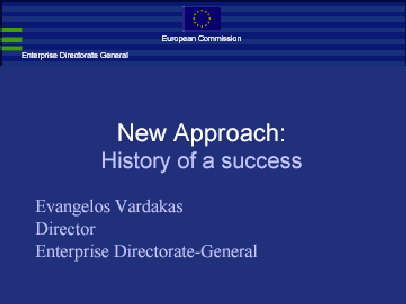
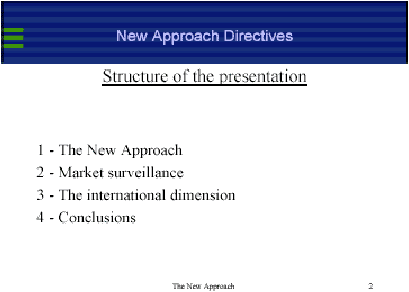
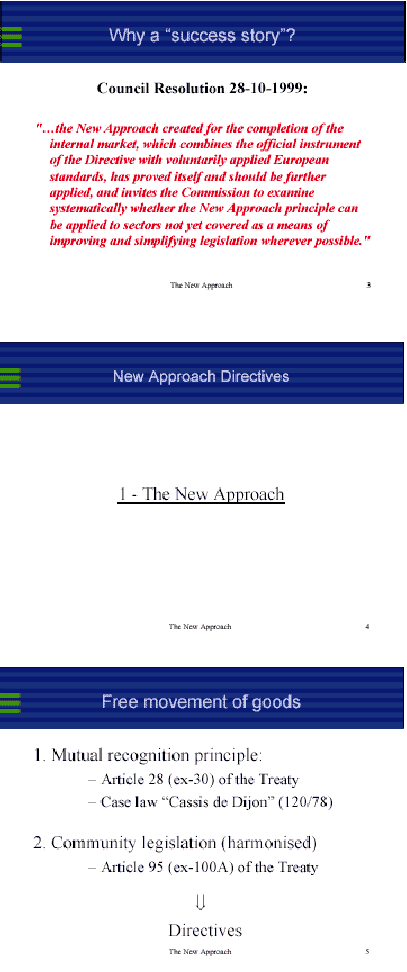
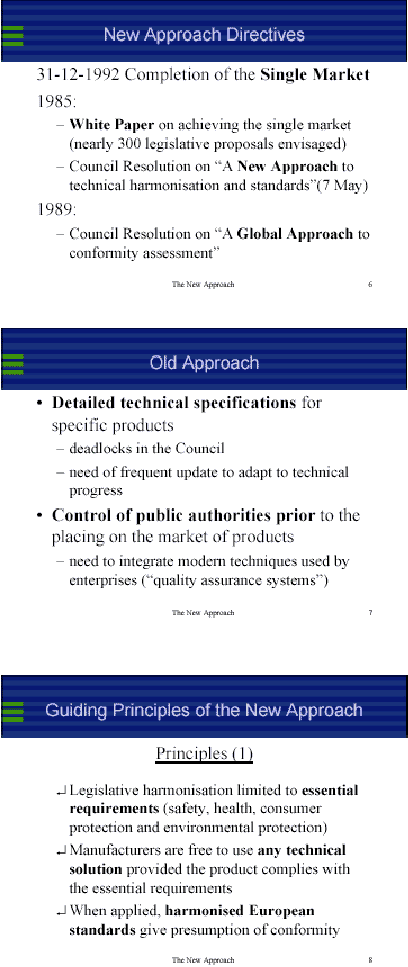
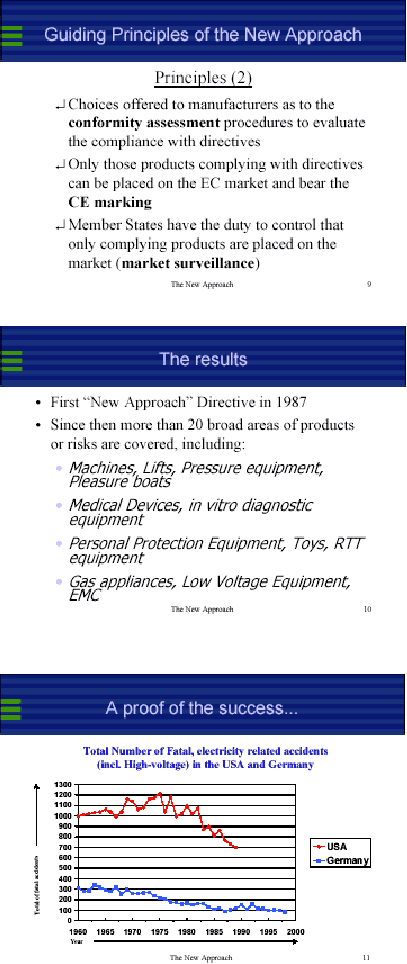
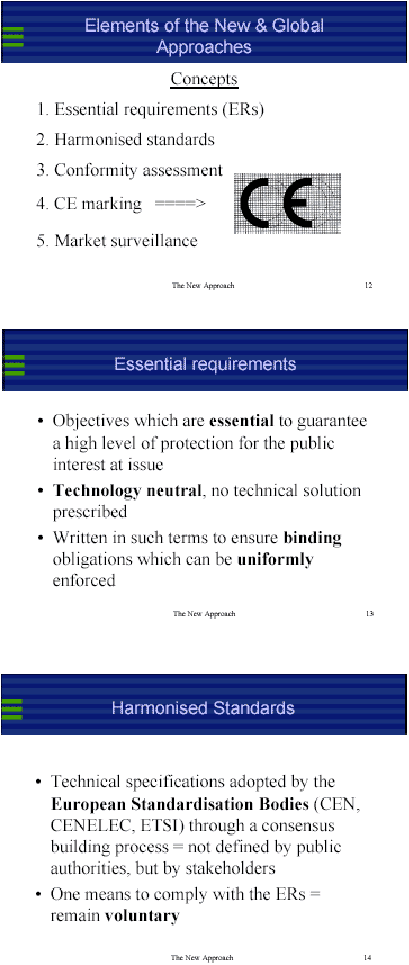
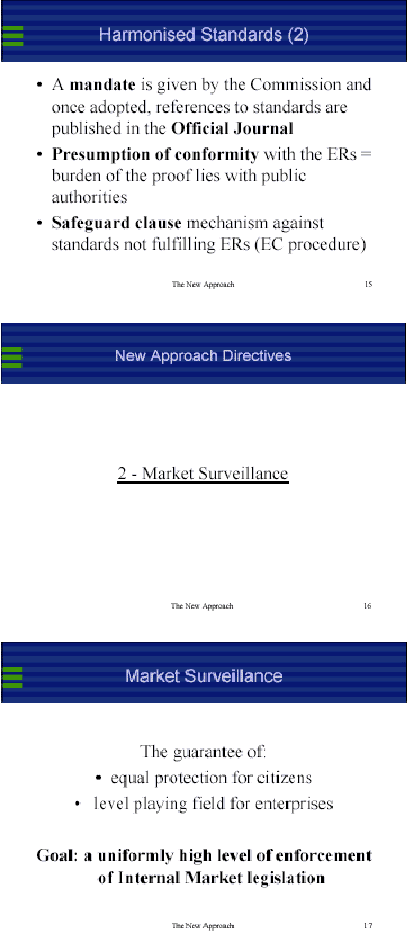
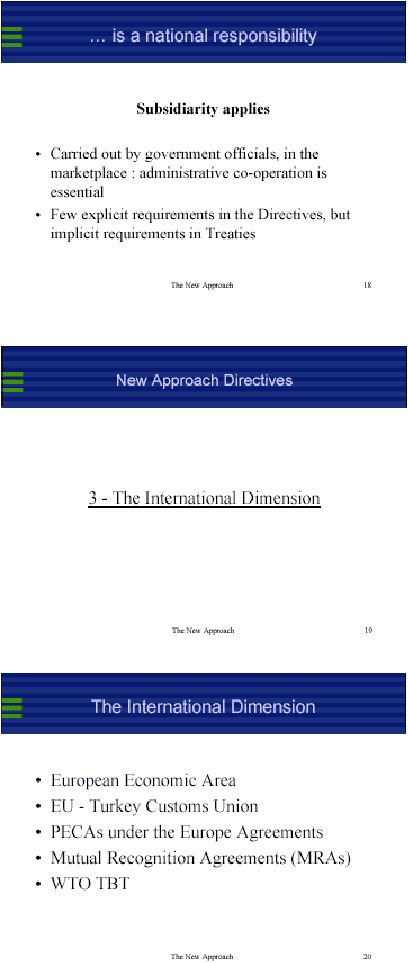
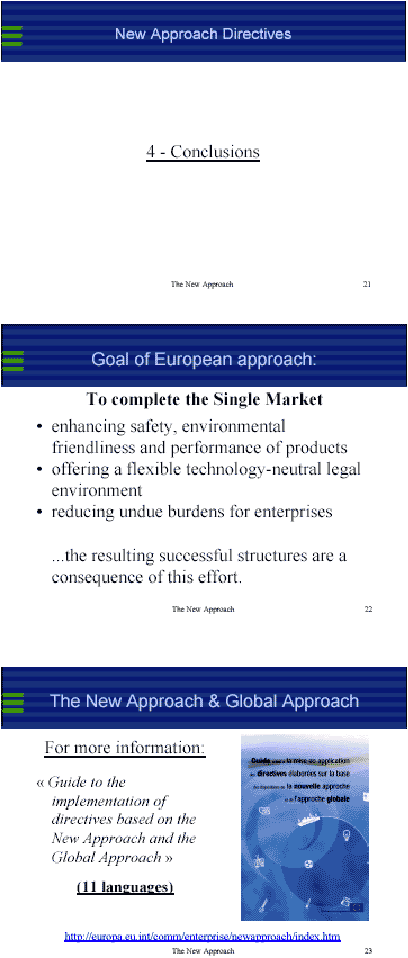
Michail Papadoyannakis, European Commission, DG ENTR. E.1
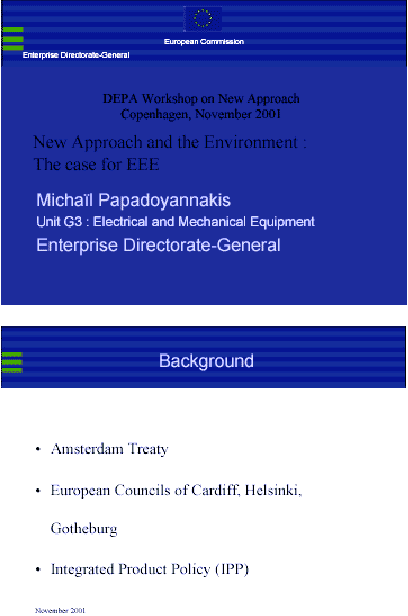

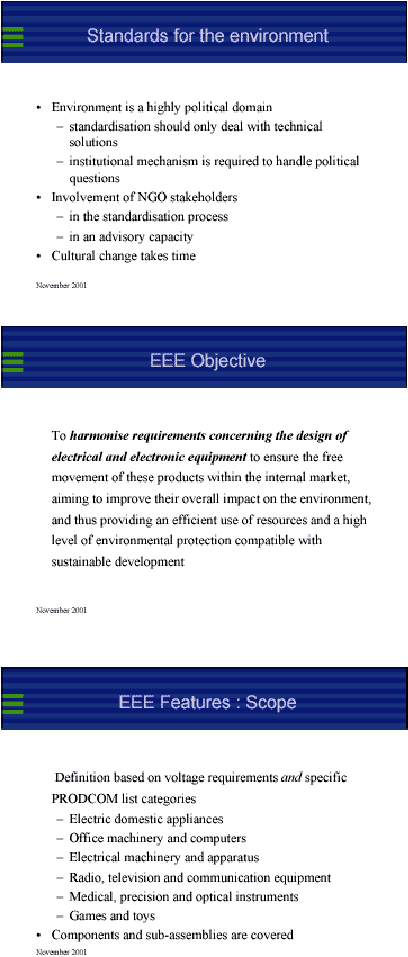
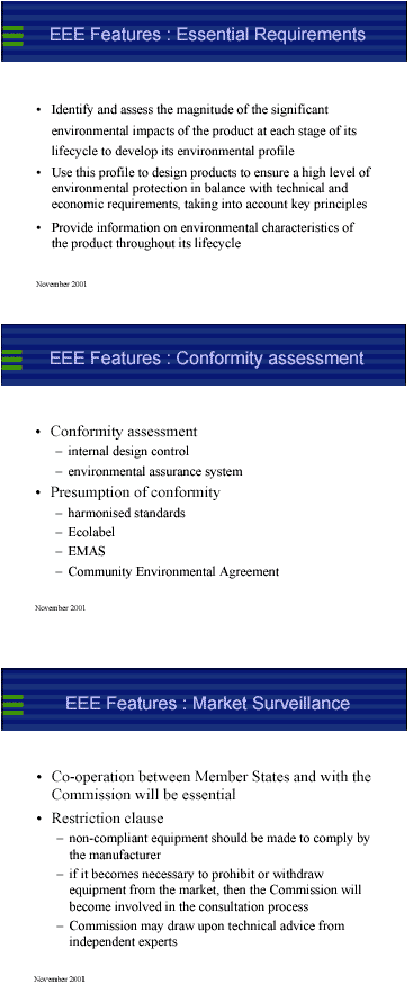
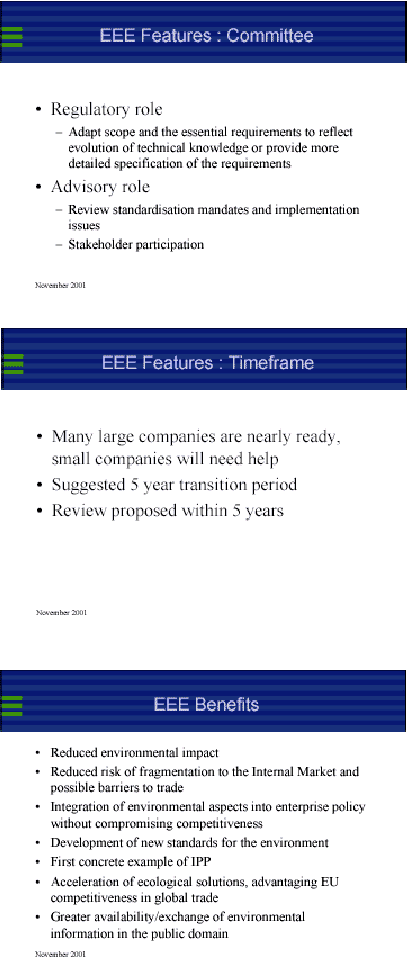
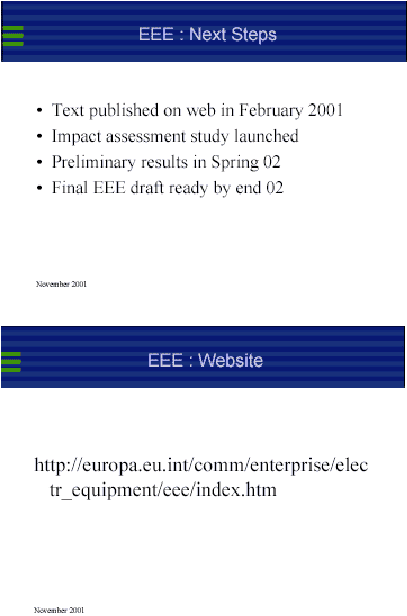
David Perchard, CEN Consultant on Packaging, Perchards
The Directive
The Packaging and Packaging Waste Directive (94/62/EC) came into force on 31 December 1994. It covers all packaging marketed in the EU and all household, commercial and industrial packaging waste.
The aims of the Directive are to:
| harmonise national measures so as to prevent or reduce the impacts of packaging on the environment of all member states and of third countries, and to remove obstacles to trade and distortion and restriction of competition; and to |
| prevent the production of packaging waste, and reduce the amount of waste for final disposal through packaging reuse, recycling and other forms of recovery. |
Member states must
take action to reduce the quantity and the harmfulness to the environment of materials and substances used and in general promote 'clean' products and technology; | |
ensure other preventive measures are taken, such as 'collecting and taking advantage of' packaging waste prevention initiatives being taken; | |
set up systems to recover at least 50% of packaging waste and no more than 65% by July 2001 and to recycle at least 25% and no more than 45% of packaging materials, with no material recycled at less than 15%; | |
notify the Commission of measures adopted or to be adopted; | |
report on progress and set up national databases so implementation can be monitored; | |
'where appropriate', encourage the use of materials recovered from recycled packaging waste in the production of new packaging and other products; | |
ensure that by January 1998, packaging is allowed on the market only if it complies with certain 'essential requirements', which include minimisation of packaging weight and volume to the amount needed for safety and consumer acceptance of the packed product, and suitability for reuse, material recycling, energy recovery or composting; | |
limit heavy metals content to 600 ppm by July 1998, 250 ppm by July 1999 and 100 ppm by July 2001; | |
| allow free access to packaging complying with the Directive. |
Use of recovery capacity outside a member state counts towards achievement of that member state's targets, provided this takes place on the basis of agreements and within EC rules.
Member states may
encourage reuse systems for packaging 'which can be reused in an environmentally sound manner', provided they do not conflict with the EC Treaty; | |
introduce economic instruments to implement the objectives of the Directive provided they are in accordance with the principles governing Community environmental policy; | |
set themselves targets higher than 65% recovery, 45% recycling and a minimum of 15% recycling for each material, but only if they have appropriate recycling/recovery capacity and provided the measures taken do not distort the internal market or hinder other member states' ability to comply with the Directive. However they must pre-notify the Commission, which must verify that the proposals will not constitute arbitrary discrimination or a disguised restriction to trade. |
Greece, Ireland and Portugal may decide to set lower targets than those required for the other member states, but must achieve at least 25% recovery by mid-2001. By the end of 2005 they must however meet the targets laid down for the other member states to achieve by mid2001.
The 'Article 21 Committee' - a committee of national civil servants, chaired by a Commission official - was to decide how to deal with any problems in applying the Directive to particular products or packs; exemptions from the heavy metal limits (e.g. for recycled materials and materials in closed loops); and any adaptations to scientific and technical progress needed.
The committee would later examine member states' practical experience in implementing the targets and the findings of scientific research and evaluation and fix targets for the second five-year phase, which, it was envisaged, would be substantially higher than the present targets.
The Commission was to promote new European standards on criteria and methodologies for packaging LCAs; methods for measuring and verifying the presence and release into the environment of heavy metals and other dangerous substances in packaging and packaging waste; criteria for minimum recycled content in appropriate types of packaging; criteria for recycling methods; criteria for composting methods and produced compost; and criteria for the marking of packaging (see section on the Essential Requirements and the CEN standards).
The proposed revisionProgress
The Directive requires the Council to set targets for the second fiveyear phase (i.e. from 1 July 2001) by the beginning of 2001. To meet this timetable, the Commission would have needed to publish its proposal early in 2000.
This was indeed DG Environment's intention, but because of the late transposition of the Directive into national law and the need to evaluate experiences and the costs and benefits of potential revised targets, it was eventually decided to delay. DG Environment explains that the timing of its proposal is a compromise between the availability of analytical information and the wish to adopt the new targets as early as possible to give member states maximum time to make legislation to allow achievement of the targets by 2006.
DG Environment's proposal entered Interservice consultation within the Commission on 5 July but at the time of writing, internal agreement has not yet been reached. It will be well into 2002 before a revised Directive can be adopted.
As expected, DG Environment proposes to limit the revision to targets and definitions. However, the explanatory memorandum says that there are other important issues which must be addressed 'in the near future'. One of these issues related to the standards and the New Approach.
In its proposal, DG Environment commented that the Packaging and Packaging Waste Directive was the first application of the New Approach to legislation on the environmental characteristics of products. There had been intensive debate about the drafting of Article 9 and Annex II of the present Directive and about whether the CEN standards should give presumption of conformity with the Essential Requirements. More analysis and debate was needed, and this was foreseen for the Communication/White Paper on IPP and the Thematic Strategy on Recycling. Ideas may also emerge from the planned Directive on Electrical and Electronic Equipment.
DG Environment's latest thoughts were set out in a Working document on aspects related to the Packaging and Packaging Waste Directive to be reviewed after the current revision proposal, dated 27 August 2001:
"The experience with the existing system of Article 9 and Annex II of the Directive and the related standards produced by CEN has shown a number of difficulties. In particular, the following issues need to be addressed:
There is a need to clarify whether and how the New Approach technique should continue to be the basis for defining environmental requirements for packaging. Within the current application of the new Approach, the Essential Requirements may not be drafted clearly enough to guarantee a harmonised application throughout the Community. Therefore, it will be necessary to define whether the current elements of Annex II should be maintained or changed. If they are maintained, it will be necessary to define how the various elements should relate to each other (cf. CEN umbrella standard). There may also be a need to separate more clearly political issues such as the definition of minimum calorific values, weight percentages to be recycled, rotation number etc, from technical issues and/or ensure a better coordination between the political levels and standardisation. Finally, it needs to be seen how the current work by CEN can be integrated into a New Approach framework and/or how the standards the references to which have not been published can be finalised.
The Commission has understood the wish by member states to move forward as rapidly as possible with this issue. Due to the fundamental impacts of potential changes to the current approach, an in-depth debate (on the basis of options still to be identified) will be necessary. This may also be an important precedent for other fields of product-related environmental policy. As the issue of the application of the New Approach technique for environmental design of products will also be addressed in the White Paper on Integrated Product Policy (to be adopted end 2001/beginning 2002), it seems appropriate to build upon the elements that will be identified there. Nevertheless, preparation work could start in parallel and first thoughts on concrete options could be laid down in a working document for the next meeting of the Committee."
The Essential Requirements
The Packaging and Packaging Waste Directive says that member states must ensure that by January 1998, packaging is allowed on the market only if it complies with certain 'essential requirements':
Packaging shall be so manufactured that the packaging volume and weight be limited to the minimum adequate amount to maintain the necessary level of safety, hygiene and acceptance for the packed product and for the consumer. | |
Packaging shall be designed, produced and commercialized in such a way as to permit its reuse or recovery, including recycling, and to minimize its impact on the environment when packaging waste or residues from packaging waste management operations are disposed of. | |
Packaging shall be so manufactured that the presence of noxious and other hazardous substances and materials as constituents of the packaging material or of any of the packaging components is minimized with regard to their presence in emissions, ash or leachate when packaging or residues from management operations or packaging waste are incinerated or landfilled. |
Where packaging is claimed to be reusable, the following requirements must be simultaneously satisfied:
the physical properties and characteristics of the packaging shall enable a number of trips or rotations in normally predictable conditions of use, | |
possibility of processing the used packaging in order to meet health and safety requirements for the workforce, | |
| fulfil the requirements specific to recoverable packaging when the packaging is no longer reused and thus becomes waste. |
All packaging must be recoverable in one or more of the following ways:
Packaging recoverable in the form of material recycling: Packaging must be manufactured in such a way as to enable the recycling of a certain percentage by weight of the materials, used into the manufacture of marketable products, in compliance with current standards in the Community. The establishment of this percentage may vary, depending on the type of material of which the packaging is composed. | |
Packaging recoverable in the form of energy recovery: Packaging waste processed for the purpose of energy recovery shall have a minimum inferior calorific value to allow optimization of energy recovery. | |
Packaging recoverable in the form of composting: Packaging waste processed for the purpose of composting shall be of such a biodegradable nature that it should not hinder the separate collection and the composting process or activity into which it is introduced. | |
Biodegradable packaging: Biodegradable packaging waste shall be of such a nature that it is capable of undergoing physical, chemical, thermal or biological decomposition such that most of the finished compost ultimately decomposes into carbon dioxide, biomass and water. |
The Directive also limits the heavy metals content of packaging, to 250 ppm by July 1999 and 100 ppm by July 2001.
The Commission's Mandate
The European Commission mandated CEN, the European Committee for Standardisation, to prepare a set of standards to give effect to the Essential Requirements. The intention was that their references would be published in the Official Journal as recognition of their status as 'harmonised standards'. Once the references have been published, packaging in compliance with the harmonised standards would be deemed to be in conformity with the Essential Requirements, and could not be denied access to any country in the European Economic Area on grounds of non-conformity with the Directive.
The six principal standards have all been adopted by a large majority and they are now being published by CEN's 19 members (the national standards bodies) as harmonised national standards.
EN 13427, Packaging - Requirements for the use of European Standards in the field of packaging and packaging waste (88% of the votes cast were in favour, with Austria, Denmark and Ireland voting against and Belgium abstaining); | |
EN 13428, Packaging - Requirements specific to manufacturing and composition - Prevention by source reduction (again, 88% of the votes cast were in favour, Austria, Denmark and Ireland voted against and Belgium abstained); | |
| EN 13429, Packaging - Requirements for relevant materials and types of reusable packaging (86% of the votes cast were in favour, Austria and Spain voted against and Belgium, Denmark and Portugal abstained); |
| EN 13430, Packaging - Requirements for packaging recoverable by material recycling (92% of the votes cast were in favour, with Denmark and Ireland against and Belgium abstaining); |
| EN 13431, Packaging - Requirements for packaging recoverable in the form of energy recovery, including specification of minimum interior calorific value (96% of the votes cast were in favour, with Denmark against and Switzerland abstaining); |
| EN 13432, Requirements for packaging recoverable through composting and biodegradation - Test scheme and evaluation criteria for the final acceptance of packaging (all votes cast were in favour, but the Czech Republic and Greece abstained). |
Standards can be adopted when (i) an absolute number of members is in favour and (ii) at least 71% of the votes cast are affirmative. As in the EU voting system, national votes are weighted according to the population of the countries concerned.
CEN submitted the complete package of texts to the Commission, with a request for publication of the references in the Official Journal. Belgium and Denmark lodged objections, and DG Environment's Waste Management Unit issued an appraisal which was highly critical of the standards. The Article 21 Committee considered the Waste Management Unit's comments and held a lengthy question-and-answer session with the CEN Consultant on Packaging and the Environment on 6 October 2000, and it examined conformity of the standards with the Essential Requirements at its meeting on 16 January; however the committee remained divided.
The Commission submitted a draft Decision to the Committee on Standards and Technical Regulations set up under Directive 98/34. The '98/34 Committee' met on 15 March, and was also divided. Very unusually, the Commission took a vote, and concluded from this that it had sufficient support to proceed. After a further discussion at the 98/34 Committee on 27 June, Decision 2001/524/EC was adopted by the Commission the following day.
The Decision records the Commission's intention to publish only two of the references to the harmonised CEN standards in the Official Journal:
EN 13428, the standard on prevention by source reduction (but with a warning that it does not take adequate account of noxious and hazardous substances and so does not fully comply with the Essential Requirements in the Packaging and Packaging Waste Directive); and | |
EN 13432, the standard on organic recovery. |
Standards whose references have not been published still exist as harmonised CEN standards, and individual member states are free to accept compliance with them as evidence of conformity with the Essential Requirements. However, there is no presumption of conformity, so member states are not obliged to grant market access to packaged products which meet the requirements of these standards. Member states choosing not to recognise the validity of the CEN standards for this purpose will have to find another way of testing conformity with the Essential Requirements.
DG Enterprise and DG Environment have drafted a 'second standardisation mandate' to revise the prevention, reuse, material recycling and energy recovery standards and to incorporate the 'umbrella standard' in the new mandate. The draft has been circulated to the member states for comment and the Commission submitted a further draft to the 98/34 Committee on 11 October. The Commission hopes that CEN can adopt amended standards as quickly as possible, but it may take some time to reach a consensus among the stakeholders.
The CEN approach
In view of the enormous range of packaging types and recovery and disposal situations which have to be taken into account, CEN Technical Committee TC261/SC4 on Packaging and the Environment opted for a management system approach aimed at ensuring a continuous effort to improve the environmental profile of the packaging placed on the market. To comply with the standards, packaging designers and specifiers will have to work methodically through a checklist to ensure that their decisions take account of the often conflicting social, environmental and economic factors affecting the choice of packaging, and find a solution that is right for the product, for the distribution system and for how it will eventually be stored and used.
The texts consist of six principal standards and a series of supporting standards, as well as reports on heavy metals and other dangerous substances and on avoiding substances and materials which might present a sustained impediment to recycling.
In addition to the five mandated standards (on prevention, reuse, material recovery, energy recovery and organic recovery), the CEN experts have prepared a standard on requirements for the use of European standards in the field of packaging and packaging waste, the so-called 'umbrella standard'. This is the key document which explains how the interlocking mandated standards and reports are to be used.
The CEN thinking is that by providing practical guidelines on how the Essential Requirements can be interpreted and implemented, the new standards will ensure that packaging designers and specifiers keep potential environmental improvements under continuous scrutiny, as well as giving added value in developing the European Single Market for packaging and packaged goods.
CEN 'umbrella standard' (EN 13427)
The Standard on Requirements for Use of European Standards in the Field of Packaging and Packaging Waste (the 'umbrella standard') guides users through the texts, indicating which standards are applicable to each type of pack.
Compliance with the Essential Requirements will involve the supplier in the detailed consideration of up to five mandated standards and one mandated report (in two parts) before placing the packaging or packed product on the market. They are all potentially capable of reducing the environmental impact of packaging disposed of as waste but they can be mutually exclusive in some combinations and circumstances. Thus the 'umbrella standard' has been introduced to establish an overall methodology:
all packs must be assessed against the standard on prevention (which includes both source reduction and the methodology for minimising noxious and other dangerous substances), and with reference to the report on minimisation of heavy metals; | |
where reuse is claimed, packs must be assessed against the standard on reuse; and | |
packs must be assessed against at least one and if appropriate all of the standards on material recovery, energy recovery, and organic recovery. |
Usually a number of components will be brought together to form a functional unit of packaging and these may in turn be brought together in a complete packaging system which could comprise primary, secondary and tertiary packaging:
Packaging at the component level should be assessed for minimisation of heavy metals and noxious and hazardous substances; | |
Packaging at the level of the functional unit should be assessed for reuse, material recovery, energy recovery and/or organic recovery (as appropriate); | |
Any complete packaging system should be assessed for prevention by source reduction. |
Having identified the appropriate standards, suppliers must then work through a series of checklists to ensure that all relevant factors have been taken into account in the design of the packaging system. For instance in terms of product protection there may be trade-offs between the primary packaging and the transport packaging (outer cases and wrappings, pallets etc).
The supplier is to apply the requirements of the selected standards to packaging he places on the market, so as to ensure that
the packaging system contains the minimum adequate amount of the chosen material (EN 13428); | |
the packaging components contain less than the maximum permitted levels of heavy metals and only the minimum amount when used for functional purposes (CR 13695-1); | |
the packaging components have been assessed to minimise the presence of noxious and other hazardous substances (EN 13428 and prCR 13695-2); and | |
the functional packaging is reusable if reuse is claimed (EN 13429), and recoverable by material recycling, recoverable in the form of energy and/or compostable or biodegradable in accordance with the relevant standards (EN 13430, 13431 and 13432). |
A summary of the assessment results must be prepared. Records of the assessments and supporting documents must be retained by the supplier for at least two years after the relevant packaging has been placed on the market for the last time. These records must be available for inspection.
The 'umbrella standard' recognises that optimisation of the effect of one procedure may require moderation in the application of others. A significant element of selecting and applying the standards will be to determine the most appropriate balance between them for any particular application.
The supplier is recommended to apply these principles as an integral part of his formal management system, for example by incorporating the procedures into an existing EN ISO 9000 / 14000 scheme, so as to improve the environmental performance of his operation and to provide the opportunity for continuous improvement.
CEN standard on prevention by source reduction (EN 13428)
'Prevention by source reduction' is defined as a 'process for the achievement of a minimum adequate weight and/or volume, for identical requirements, of primary and/or secondary and/or tertiary packaging, when performance and user acceptability remain unchanged and/or adequate, thereby minimising the impact on the environment.'
The standard specifies a procedure for assessment of packaging to ensure that the weight and/or volume of its material content is at the minimum commensurate with the maintenance of
functionality throughout the supply and user chain; | |
safety and hygiene for both product and user/consumer; | |
acceptability of the packed product to the user/consumer. |
The substitution of one material for another is not a basis for source reduction.
The standard is based on a self-assessment approach similar to the approach in systems standards such as the EN ISO 9000 and EN ISO 14000 series. It could be used by any producer, user or distributor as a methodology for demonstrating that the minimum amount of weight and/or volume of the finished packaging has been reached taking into account the relevant performance criteria.
The basis for complying with the standard is identification of the 'critical area' which governs the achievable limit for source reduction. That is to say, if the packaging is reduced further, it will fail to meet the listed performance criteria:
| product protection; | |
| packaging manufacturing process; | |
| packing/filling process; | |
| logistics (including transport, warehousing and handling); | |
| product presentation and marketing; | |
| user/consumer acceptance; | |
| information; | |
| safety; | |
| legislation; | |
| other issues. |
If no critical area is identified, the packaging is not in compliance with the standard and the potential for (further) source reduction is to be investigated. If on the other hand tests show that further source reduction will result in an unacceptable increase in the packaging failure rate, the critical point has already been reached.
[An 'unacceptable' failure rate must be a matter of commercial judgement - it may be different for a high-value product than a low-value item, and for products where leakage could endanger people or property - and this judgement must be shared between the producer, the customer and possibly the enduser.
The packaging manufacturing or packing/filling process also has to be taken into account. It may be possible for the producer to reduce his packaging further, but only by purchasing new machinery. This may not be economically practicable, and it may not be environmentally desirable for the existing equipment to be scrapped before it reaches the end of its life.
If the packaging is source reduced to the point where the product is unacceptable to the consumer, it will not sell, and there is no point producing it. Consumer acceptability is listed among the Essential Requirements.]
An Annex sets out guidelines on the use of the standard. It can be used in the assessment of existing packaging or as an aid in the normal dialogue between supplier and customer in agreeing a specification for new packaging. The Annex
describes the different phases of the assessment process; | |
reviews the ten specific performance criteria and lists typical requirements in order to help users of the standard identify the important and decisive requirements applicable to the packaging under assessment; and | |
gives examples of completed assessment checklists and their supporting reports together with explanatory documents which support the completion of the checklists. |
The company responsible for compliance must prepare a statement of conformity with the assessment procedures and determination of critical area, together with supporting documentation, based either on their internal documentation or on a checklist. In either case all listed performance criteria must be covered.
The enforcement authorities can verify compliance with the standard by asking the producer to demonstrate the steps that have been taken to identify the 'critical area'. If this cannot be done, the packaging fails the standard.
The supplier must also be able to demonstrate that only the minimum adequate amount of any substance dangerous to the environment has been used in the packaging or packaging component, with a view to minimising its presence in ash, emissions or leachate from landfills. The methodology for this is fully explained in the draft CEN report prCR 13695-2 (Packaging - Requirements for measuring and verifying heavy metals and other dangerous substances present in packaging, and their release into the environment - Part 2: Requirements for measuring and verifying dangerous substances present in packaging and their release into the environment).
The evaluations to be undertaken are as follows:
Have such substances been intentionally added? If not, or if they are used but only in concentrations below trace level, minimisation is not applicable. | |
Are any of the substances identified likely to be released into the environment from ash, emissions or leachate resulting from incineration or landfilling of the packaging or any packaging component after use? If not, minimisation is not applicable. | |
If any of these substances are likely to be released into the environment, the supplier must ensure minimisation and document the results of the procedure. |
This standard contains a checklist by which the packer or filler can assess 'reusability'. If the pack fails any of these three tests, it is deemed unfit for reuse:
packer/fillers must intend to reuse the pack for its original purpose (i.e. a pallet which can be used for grocery products or house bricks is 'reuse for the same purpose'; a mustard container intended for a secondary life as a drinking glass is not 'reuse for the same purpose'; the refilling with homemade jam of jars originally containing commercially-made jam is not 'reuse for the same purpose'); | |
it must be possible to clean, wash and/or repair the pack after emptying and to refill or reload it; | |
a system which supports reuse of the pack must be available. This may be a 'closed loop' system (in which reusable packaging is circulated by a company or an organised group of companies; an 'open loop' system (in which reusable packaging circulates amongst unspecified companies) or a 'hybrid' system (in which reusable packaging stays with the end-user and is replenished by means of one-way packaging which is used as an auxiliary product to transport the contents to the reusable packaging). |
Auxiliary products (e.g. a detergent pouch) are one-way products and are not covered by this standard, but non-reusable items which support the reusable packaging in its function (e.g. labels or closures) are considered part of that packaging.
CEN standard on material recycling (EN 13430)The standard covers all forms of packaging and types of packaging material, and all collection and sorting arrangements and recycling facilities. It formalises a procedure by which design, production and use of packaging can be checked against the requirements of various material recycling systems.
Those responsible for placing packaging and/or packaged products on the market must be able to demonstrate that the procedures defined have been followed in arriving at the final design of the finished packaging such that a certain percentage of material can be recycled.
For material recyclability to be claimed, they must
ensure that packaging design takes account of the recyclability of the materials from which it is produced; | |
control selection of raw materials used in production/ packing/filling operations and where practicable collection/sorting operations to ensure that they do not adversely affect recycling processes; | |
ensure that the design of packaging makes use of materials
or combinations of materials which are compatible with known and relevant recycling
technologies whilst also recognising the interrelationship of the various standards
supporting Directive 94/62 | |
establish a system to ensure that new developments in relevant recycling technologies are monitored and recorded and that such records are made available to the design function; and | |
take account of the potential change in releases to the environment that will result from introducing the used packaging to the recycling process. |
The procedure for assessing recyclability criteria is as follows:
Design should ensure that the packaging is compatible with the specifications of related recycling technologies, enables a certain percentage by weight of materials to be recycled, and takes into account
| substances or materials liable to create technical problems in the recycling process (see CR 13688, a CEN report on Requirements for substances and materials to prevent a sustained impediment to recycling); |
| materials, combinations of materials or designs of packaging liable to create problems in collecting and sorting before material recycling; and | |
the presence of substances or materials liable to have a negative influence on the quality of the recycled material. |
As regards production criteria,
ensure that any changes in packaging raw material sourcing / manufacture, conversion and filling can be managed so that they cannot adversely affect the compatibility of the packaging with the recycling process; | |
ensure that materials selected in the design stage as causing no significant problems for recycling technologies, are not changed during the process so as to adversely affect compatibility with the specification of the recycling process (this also applies to changes in other constituents such as adhesives, inks and coatings and to components such as labels, closures and other sealing materials). |
Utilisation criteria are to
ensure that the construction is without prejudice to the conformance with other Essential Requirements, and the requirement that it meets the safety, hygiene and consumer needs of the packaging; | |
ensure that the design of the primary packaging (e.g. its shape, design and location of the opening, etc) will enable emptying of the packaging so that the used packaging is compatible with the recycling process; | |
ensure that where the packaging comprises more than one material component which need to be separated to be compatible with the collection system linked to the recycling process, the packaging is constructed so that the end-user can carry out the separation under normal and foreseeable circumstances; | |
ensure, as far as practicable, that information has been sought regarding any particular requirements of the expected and relevant collection and sorting process and that the design and construction of the packaging takes these into account. (The standard recognises that this may be impracticable if the packaging does not have a specific destination, since there are significant differences in systems available within and between the member states). |
The standard also explains that the CEN report, Packaging - Marking and material identification system, recommends that any material identification should be recognisable to its target groups, so as to facilitate clear and unambiguous identification of the predominant material. Identification of the predominant material may help the packaging user by indicating a disposal option, or may facilitate collection and sorting, or the aggregation of materials into recycling streams. However the nature of some materials is clear without the need for applied identification, and recognition may also be assisted by means such as colour or container shape.
CEN standard on energy recovery (EN 13431)This standard specifies the requirements for packaging to be considered as suitable for energy recovery and identifies the necessary procedures for a supplier placing packaging on the market to claim conformity with these requirements. The scope is limited to factors under the control of the supplier.
Packaging claimed to be suitable for energy recovery must be combustible and capable of providing calorific gain, as determined by the method specified. In addition,
packaging composed of over 50% by weight of organic materials (e.g. wood, cardboard, paper and other organic fibres, starch, plastics) provides calorific gain and shall be considered recoverable in the form of energy; | |
packaging composed of over 50% by weight of inorganic material (e.g. ceramic, glass, clay, metals) may be declared recoverable in the form of energy when supported by evidence of the calorific gain; | |
thin gauge aluminium foil (up to 50 µm thick) shall be considered recoverable in the form of energy. |
Calorific gain is assumed to be fulfilled when the net heat of combustion exceeds the amount of energy required to raise the temperature of the postcombustion substances from ambient temperature to the specified final temperature, without heat entering or leaving the system. The standard provides a formula for calculating the net calorific value of a packaging consisting of different constituents.
Compliance assessment by the supplier shall be supported by records, providing as and
when required the following information as a minimum: composition by main materials with particular reference
to whether it may be considered organic or inorganic; and the calorific gain, when appropriate.
![]()
![]()
CEN standard on organic recovery (EN 13432)
This standard defines the requirements for packaging to be considered as recoverable through composting and biodegradation.
A pack is deemed organically recoverable when each pack, packaging material or packaging component fulfils the following criteria:
they are inherently and ultimately biodegradable as demonstrated in laboratory tests, and to the criteria and pass levels laid down; and | |
they disintegrate in a biological waste treatment process to the criteria and pass levels laid down, without any observable negative effect on the process; and | |
| when submitted to a biological waste treatment process, no negative effect on the quality of the resulting compost is recorded. |
Packaging or packaging components intended for the biowaste stream must be recognisable by the end-user as compostable or biodegradable.
The standard covers the compostability of the packaging itself but does not address regulations that may exist regarding the compostability of any residual contents.
The standard is only intended to obtain information on the processing of packaging in controlled waste treatment plants, and does not take into account packaging waste which may end up in the environment through littering or other uncontrolled means.
Each packaging material under investigation must be identified and characterised prior to testing, including at least
information on, and identification of, the constituents of the packaging materials; | |
determination of the presence of hazardous substances (e.g. heavy metals); and | |
determination of the organic carbon content, total dry solids and volatile solids of the packaging material used for biodegradation and disintegration tests. |
Constituents known to be or expected to be harmful to the environment during the biological treatment process, in excess of the limits laid down, may not be introduced into packaging or packaging materials intended to be designated as suitable for organic recovery.
If a packaging material is demonstrated to be organically recoverable in a particular form, the same packaging material in another form, having a smaller mass to surface ratio or wall thickness, is also regarded as organically recoverable. Chemically unmodified packaging materials of natural origin (e.g. wood, wood fibre, cotton fibre, paper pulp or jute) can be accepted as biodegradable without testing, but have to be chemically characterised and must fulfil the criteria for disintegration and compost quality.
The results of each assessment or test undertaken must be recorded on an assessment checklist and their combined outcome used to determine whether a packaging material or a pack is biologically treatable and therefore suitable for organic recovery. The checklist, together with any externally sourced data or other information needed to support the conclusions reached in the assessments, must be retained and made available for inspection as required. The standard includes a recommended format for a conformity assessment checklist.
The evaluation criteria laid down include pass levels for Zn, Cu, Ni, Cd, Pb, Hg, Cr, Mo, Se, As and F. It is assumed that 50% of the original weight of the packaging or packaging material will remain in compost after biological treatment together with 100% of the original amount of hazardous substances.
CEN report on requirements for measuring and verifying heavy metals and other dangerous substances present in packaging, and their release into the environment (CR 13695-1 and prCR 13691-2)Part 1 of the report, which deals with the four heavy metals controlled by the Directive, was published in March 2000. Part 2, which covers other dangerous substances, will be available shortly.
Part 1 notes that very few examples of the intentional introduction of heavy metals into packaging and packaging materials have been identified. These are listed in the report.
Two ways of assessing heavy metals content are possible:
The preferred method is through calculation (the so-called 'upstream approach'). The manufacturer of the packaging component asks the suppliers of each constituent to provide him with information on its heavy metals content, and aggregates this information. If the heavy metals content exceeds the limits - having regard to any derogations - he must ensure that this is corrected before he issues his statement of conformity. Similarly, packaging convertors and packer/fillers assemble information from their suppliers and calculate the total heavy metals content reported. | |
| If information on the heavy metals content is not available, the statement of conformity must be based on the results of tests on a representative sample, carried out by a qualified laboratory. |
Part 2 of the report will enable the component and/or packaging manufacturer to demonstrate that the introduction of substances dangerous to the environment has been minimised. These substances are those
classified as dangerous by Directive 67/548/EC and its amendments; | |
intentionally introduced for functional purposes; | |
present in individual concentrations equal to or above trace level (0.1% by weight); and | |
liable to be released into the environment during incineration or after landfilling. |
Where all four of these conditions apply, the component and/or packaging manufacturer must ensure and be able to demonstrate that he has added only the minimum amount of the substance(s) needed for the functional purpose.
The draft report says that there are no general standardised methods for the systematic measurement of the presence of these substances in ash, emissions or leachate, so the 'upstream approach' is again recommended.
2.1.4 The challenge of verifying compliance with essential requirements.Richard Lawson, Deputy Director of Standards and Technical Regulations, UK Department of Trade and Industry
The challenge of verifying compliance with essential requirements
Richard Lawson, Deputy Director of Standards and Technical Regulations, Department of Trade and industry
Synopsis of Presentation
The presentation will begin with a brief explanation of the UK's legislative traditions in the field of product safety and how it has coped with the transition to harmonisation on the basis of the New Approach. It will go on to consider some of the benefits that the New Approach has brought about. It will give practical examples in the field of Machinery safety together a reference to our more limited experience in the field of Packaging and Packaging Waste. It will then try to illustrate how the Essential Requirements approach can be hampered. It will do this by giving an example of holding onto a more prescriptive approach while ostensibly doing the opposite. It will - again briefly - consider the respective roles of product standards and management standards in current safety-related New Approach legislation. It will conclude by listing some of the overall benefits we have found with the New Approach.
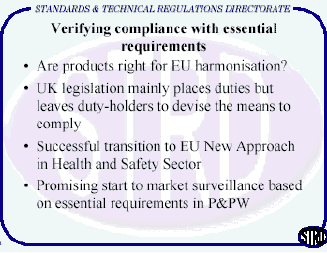
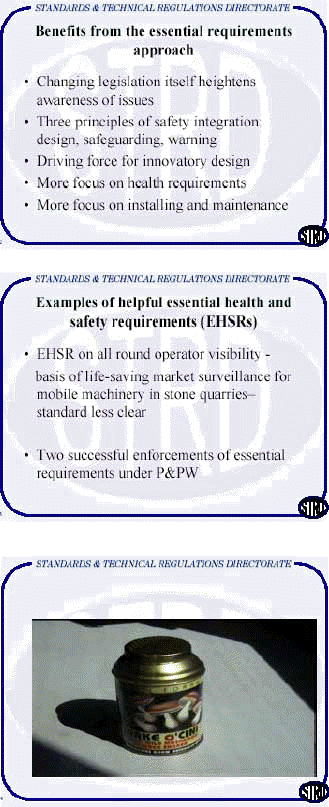
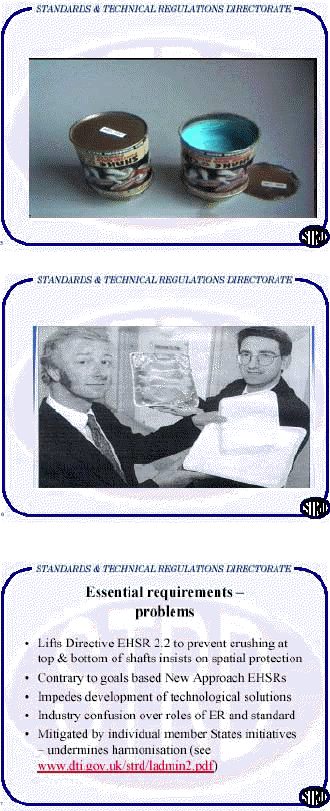
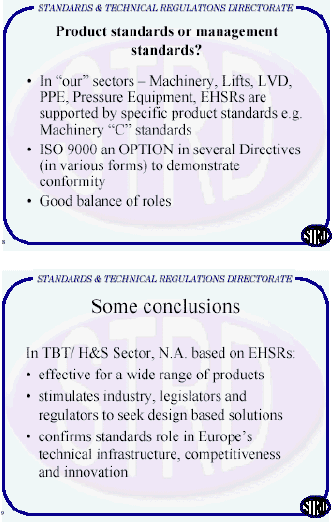
Jacob Holmblad, Vice President, CEN
Workshop on New Approach
Being CEN's vice-president, I note with great pleasure that standardization along with the New Approach have created success for the internal market in Europe.
However, the subject I wish to introduce today is 'The Interface between European and International Standards-setting' and not the internal market. This has become a live issue due to the fact that globalisation has increased the need to find an international solution on global trade. This solution should be based on the European success.
Until the mid-eighties standardization was primarily a tool for industry in the pursuit of achieving rational production and trade. The political relations were few and the national standardization bodies manifested a great degree of stability.
The change came around the mid-eighties, and was demonstrated by the ratification of the New Approach, which was one of the main elements in creating a new Europe with an internal market. Standards gained a role in relation to the directives, and by adding this legal dimension a growth generator for the standardization work had been initiated.
The work behind the establishment of the internal market was now well on its way. The future challenges are maintenance, the application of the new approach in new areas, co-regulation and international solutions.
International trade is to become the focus of attention. The philosophy behind the internal market should be put into a global perspective. The technical trade barriers throughout the world are to be removed.
The International Standards are ascribed the same role standards had in Europe before the introduction of the New Approach. In Europe the importance of standards were more far-reaching. The introduction of the New Approach launched a brave and far-sighted process within a political framework. The process itself laid down the responsibility of the parties involved - them being the manufacturers, the consumers, the authorities or whom else might be involved - in order to contribute to the creation of the internal market. There are not many other places in the world where such a confidence was shown towards the citizens' self-regulation. But it turned out to be a success, which the Commission wishes to carry on with within the framework of co-regulation. We can be very proud of this process of thought. I believe it is highly unique and it has caught considerable attention outside of Europe.
The American central administration has studied the European model for a while now - and it has been found very appealing. However, the conclusion is that the USA most likely will use it as a source of inspiration rather than an actual implementation.
The extent to which standards are used within a legislative framework is rather unique for Europe. In the rest of the world traditions and codes of practise in certain sectors are given higher priority. Therefore, it is often seen that trade-specific de facto standards regulate a certain sector.
Another important difference is that in Europe, it is a requirement to withdraw national standards for the benefit of a national implementation of European Standards. This is quite a decisive factor for the existence of the internal market. Nevertheless, this results in an imbalance in relation with whom we trade outside of Europe, as existing national standards do not have to be withdrawn as a result of the approval of ISO- and IEC-standards. If only we could achieve this, we would have achieved a lot.
The question is whether we can agree on an international model resulting in a huge global internal market? It won't be easy. In Europe there are 20 somewhat homogeneous countries while there are 150 countries in ISO, which are at different stages of development.
One possibility would be to divide the world into regions. And we already have several of them - Pacific Rim, ACEAN, EU, NAFTA etc. At first the thought would be to promote trade among countries within the regions and then afterwards start promoting trade among the regions. But this model would not work seen in the perspective of creating a larger and more equally shared wealth among countries.
As mentioned earlier, I do not believe in the popularisation of the European model. The internal market was born as a political vision. I think that the global vision will emerge as a wish to simplify and harmonize within the global market and the source of inspiration could very well be the "world standards". There is a need for worldwide-accepted standards. Present examples of worldwide-accepted standards are ISO Standard for codes for foreign exchange currency as well as ISO 9000 and ISO 14000.
We are witnessing the beginning of a shift towards international focus on certain areas. One could hope that the increased focus on health, safety, environment and also soon ethical aspects - which all are terms transcending barriers - would have an encouraging effect towards an international orientation. The value of international standards within these areas would benefit international society and trade.
Being inspired by the European model one could imagine an umbrellastandard corresponding to the requirements in the directives. This would conform to the role of the directives in the internal market. On a regional level, regional standards could be elaborated and with respect to regional differences, the standards would fulfil the requirements laid down in the umbrellastandard.
The umbrella-standard could be an intermediate stage on the journey towards harmonized international standards. The world of standardization is able to propose several solutions on an international level, but the chances of going through with them will to a great extent depend on negotiations in other international co-operating fora such as WTO.
2.2 The New Approach: ensuring a high level of protection for environment and human health (Session II)
2.2.1 Experience with the New Approach from an environmental point of view.
John Hontelez, Secretary General, European Environmental Bureau (EEB)
The New Approach in Setting Product Standards for Safety,
Environmental Protection and Human Health: Directions for the Future 29-30 November 2001,
Copenhagen
sponsored by
Danish Ministry of Industry and Trade
Danish Environmental Protection Agency
Experience with the new approach - from an environmental point of view -
By John Hontelez, Secretary General, European Environmental Bureau
Involvement of the EEB
The European Environmental Bureau consists of 140 member organisations in 27 countries and with more than 14 million members/direct supporters in these countries. The EEB works on many different environmental issues with a European perspective, including standardisation. The work with standardisation has been part of the EEB's work for ten years, so far without any specific financial support, so on a very limited scale. Logically, the focus has been the impact of standards to the environment.
On the initiative of the EEB, this year, a group of large European Environmental Organisations and several national organisations, including the Danish Society for Nature Conservation (DN), founded ECOS, the European Environmental Citizens Organisation for Standardisation). ECOS is to support and develop standardisation work in and for the environmental movement in the consciousness that standards have a huge impact on Europe's environment. ECOS has so far no financial support for its work, but we are waiting for the Commissions answer to an application we sent in August.
The evolution of environmental policy making
The environmental policy simultaneously exploded and imploded throughout the 90s. With the explosion the environmental policy decisions are diffused to new forums. Environmental policy is not determined in the demarcated national parliamentary process alone but in complex interactions and battles between private as well as public national, European, and international actors. These actors include the European Commission, WTO, ISO, CEN, CENELEC and civil society organisations like the EEB. Ofcourse they also include very much powerful business organisations, in Brussels more in particular UNICE.
With the implosion of the environmental policy I mean that environmental policy processes are narrowed down and are of an increasingly closed nature. Environmental policy decisions increasingly are being determined as being technical and transferred to relatively closed forums of experts, such as technical standardisation working groups in CEN or committees within the European Commission, often with involvement of the Member State governments, but not of the European Parliament and with a very imbalanced involvement of non-governmental players.
The risks of the New Approach
Standards are no longer simply a voluntary option amongst others, but have become the way to comply with New Approach legislation. From a strictly legal point of view, such standards may still be regarded voluntary, however in practice they have become binding. In other words, the New Approach has transformed technical standards into soft law. This in return may pose a problem for the legitimacy of the New Approach, as this legitimacy rests on the voluntary nature of standards. For us the main question then is, whether it is posing a problem from an environmental point of view. The answer is that it depends:
The standardisation bodies are private and autonomous organisations, in which the voluntary effort of industry is the driving force. It was exactly this voluntary effort which the EU wanted to draw on in the New Approach. However, industry pursues its own interests - unfortunately - and these interests are not necessarily those of the EU's citizens or the environmental movement. Hence it should not be expected that standardisation organisations by themselves realise the aims of EU's environmental policy, nor of any national integrated product policy.
The need for a clear environmental framework
This means that the Commission and the political system have to develop tools and procedures to ensure that standards indeed have a high environmental quality, that they support and reinforce EU's environmental legislation and objectives.
For the general legal basis for such a revision we refer to article 6 of the EU Treaty, which obliges the EU Institutions to ensure the integration of environmental concerns in all policy areas. This article needs to be elaborated into some much more concrete decisions for the standardisation process.
So our first demand is a framework directive on environmental demands to products, similar to the product safety-directive. It should lay down a structural and specified obligation that environmental objectives and safeguards are part of the essential requirements and that no other essential requirements can complicate the achievement of such requirements.
Secondly, the requirements of the framework directive should be specified in each New
Approach directive that, but setting concrete environmental benchmarks for the standards. Our recommendations are not developed without a context - as said, our experience is
limited as so far we do not have been given the means to get involved on a substantial
scale. But we have reason to be concerned, given the lack of interest for environmental
performance we have often seen in the main European standardisation body. There are a few
concrete examples that we have come across where the environmental performance is clearly
unacceptable. One example are the standards for heating appliances. These appeared to be violating
national legislation from Austria and Germany with regards to NOx, CO2 and volatile
organic compounds for several appliances up. Acceptance levels of the standards exceed
these national laws with between 100% and 900%. While they may not have violated law in
other countries, nor the EU regulations, it shows clearly that the EU standards are not at
all state-of-theart or with a particular environmental ambition. Another example are the standards on construction materials, where we are concerned in
particular about the tolerance towards hazardous substances. But the case we have been engaged in most is, paradoxically, the standards developed
for the only New Approach Directive with an environmental origin, the Packaging
Directive. Here we clearly see the weakness of the system: Currently, there is discussion to rely on CEN to assist in the implementation of the Electric
and Electronic Equipment Directive, in particular to set standards for management
systems. It is essential that the mistakes of the Packaging Directive won't be repeated. Attempts to find solutions The Environmental Help Desk and Environmental guidelines are two attempts from the
standardisation bodies to try to integrate environmental concerns. Both are instruments
developed inside the standardisation system, and they do not have to live up to the
requirements of the European Treaty or European Institutions, neither do their have the
possibility to change the fundament of the system. The initiatives of the standardisation bodies can not replace the political
responsibility, and therefore the main focus has to be on changing the method in a way
that raises the political influence on the process and thereby make politicians and public
authorities accountable again. To conclude: The EEB can not support use of the New Approach in the environmental field without some
major changes. We call on the EU Institutions to ensure that the New Approach is
transformed into a one that safeguards and promotes environmental interests. (September 2000) EEB Publication 2000/15 The European Environmental Bureau (EEB) The EEB is a federation of 135
environmental citizens organisations based in all EU Member Countries as well as in
several other countries and around Europe. It was established in 1974 to provide a focal
point for environmental groups in Brussels to monitor and respond to the emerging EU
environmental policy. It lobbies to improve and protect the environment of Europe and to
enable the citizens of Europe to play their part in achieving that goal. The EEB is active
both at the EU institutions level and in each Member State. Environmental organisations throughout the EU play a rich and important role in
protecting and sustaining Europe's environment. We are responsible for representing public
opinion and galvanising support for better environmental protection. We also deliver a
huge amount of environmental protection - whether directly, as managers of land and
buildings, or indirectly, through paid and voluntary work for the environment of all
kinds. We are proud of our work and achievements, and see ourselves as partners in the
search for more sustainable lifestyles and better environmental policies. Editor responsible: John Hontelez The EEB gratefully acknowledges the financial assistance by the Commission of the
European Communities. The publication reflects the author's view. The Commission is not
liable for any use that may be made of the information contained in this publication. Reproduction of all or part of the publication is encouraged with acknowledgement of
the source. Copied on recycled chlorine-free paper. 1 A
short history: the preparation of the EC Directive 94/62 2 The contents of the Directive 3 The Mandate of the
Commission to CEN 4
The organisation of the work on packaging and packaging waste standards in CEN The present paper analyses the implementation of the European Packaging and Packaging
Waste Directive (94/62/EC) through five standards elaborated by the European Committee for
Standardisation (CEN): It also considers two standards, EN 13193 - on terminology - and the socalled
"umbrella standard" EN 13427, which are frequently mentioned by all mandated
standards, although they were not the subject of a mandate from the Commission. This analysis, prepared by Susanna Paleari, of the EEB, concludes that the standards
mentioned are not consistent with the general requirements of the Directive. Consequently,
the mandate conferred by the Commission to CEN was not properly implemented. In fact, CEN did not seem to take the legal requirements of the Directive seriously and
chose a different approach. Instead of the expected thresholds and quantitative criteria,
CEN opted for a management system approach, which, along with the flexible and generic
criteria provided for in the standards, cannot guarantee that packaging to be placed on
the market complies with the essential requirements of the Directive. Moreover, CEN has consistently ignored and bypassed the critical comments made by
environmental NGOs, (whose involvement in the standardisation process was clearly required
by the Commission mandate), DG Environment and other participants in this process. The
same criticism applies to the comments on CEN standards drawn up by the Waste Management
Unit of the Directorate-General for the Environment (DG ENVE.3). These standards therefore have to be rejected. They should not be granted official
approval by being published in the Official Journal. Official approval would set a
disastrous precedent, with democratically legitimated institutions conferring a mandate
for implementation to a private body, which then reshapes it according to its personal
preferences. This would encourage CEN, and hence industry, to ignore and bypass
environmental legislation and write out its own in the future. This would raise a question
about environmental governance in Europe: is it governed by politics or by business? The
EEB is convinced that politics should have the last word, even if tasks are assigned to
private bodies. CEN could have refused to work on the mandate, if it felt it impossible to implement,
instead of which it opted for an independent reinterpretation of its tasks. By so doing,
CEN has gone beyond the terms of reference and hence beyond its rights. The failure of CEN to deliver what is required by the Packaging Directive implies
additional tasks for the forthcoming revision of the Directive itself. We believe that
safeguards need to be introduced to avoid a repetition of the CEN failure, which has
caused considerable delay in implementing the Packaging Directive. A major change of
approach in implementing its essential requirements is therefore needed. Dr. Christian Hey, EU Policy Director, EEB In 1990, the Directorate General of the Environment elaborated a first Outline
Proposal, in order to draft a Directive addressing all packaging wastes, which focused on
three basic measures: The Council added to the mentioned minimum goals a cap, limiting recovery at a maximum
of 65% and recycling at 45% of the total amount of packaging waste, aimed at regulating
the faculty of the member states to go beyond the harmonised standards. The European Packaging and Packaging Waste Directive (94/62/EC), adopted under Art.
100A of the Treaty, is aimed at preventing or reducing the environmental impact of
packaging, ensuring at the same time the functioning of the internal market (Art. 1). It
applies to all packaging placed on the market in the Community and all packaging waste, as
defined by Art. 3 par. 1 and 2. The Directive lays down provisions for, "…as first priority, prevention of
packaging waste and, as additional fundamental principles, reuse of packaging, recycling
and other forms of recovering packaging waste and, hence, reduction of the final disposal
of such waste". In particular the member states are required to take such measures
that could be necessary: to prevent the formation of packaging waste and to promote other
preventive actions; (Art. 4 and 9) to attain the recovering and recycling targets established by Art. 6, (while
particularly relaxed targets have been decided with reference to Greece, Ireland and
Portugal, because of their specific situation); to ensure the creation of return, collection and recovery systems (Art. 7); to limit the presence and the concentration in packaging of noxious and hazardous
substances, including four heavy metals, (cadmium, mercury, lead and hexavalent chromium),
(Art. 11). Besides, Art. 9 and Annex II of the Directive set out essential requirements for
packaging standards. The principles underlying the essential requirements are that: packaging weight and volume should be minimised to the amount needed for safety and for
acceptance of the packed product; noxious and other hazardous constituents of packaging should have minimum impact on the
environment when the packaging reaches its end of life; packaging should be suitable for material recycling, energy recovery or composting, or
for reuse if reuse is claimed. Member states shall ensure that three years from the date of the entry into force of
the Directive, packaging may be placed on the market only if it complies with all
essential requirements defined by the Directive itself, including Annex II (Art. 9). Art. 15 authorises member states to introduce national economic instruments (taxes or
levies) to achieve the Directive's objectives, provided any such instruments are
consistent with the Treaty, i.e. provided they do not create barriers to trade. Although the Directive introduces important requirements, it doesn't tell how packaging
producers and importers can demonstrate compliance with these requirements. In other
words, it doesn't say anything about how to design and specify packaging which will meet
these legal obligations. Consequently, the Commission charged CEN with the following
Mandate (M 200 Rev. 3): The Commission requests CEN to draw up standards for packaging and packaging
waste useful for the application of the Directive, covering all environmental aspects of
all kinds of packaging and packaging materials and reflecting the objectives of the
Directive, i.e. to prevent waste of packaging and to promote reuse of packaging and
recovery, including recycling, of packaging waste. Apart from this Mandate and some informal experts advices, no other guidance or
constraints were available to CEN because national standards on the subject were
nonexistent. According to this Mandate, three groups of standards are to be developed: standards
intended to give presumption of conformity with the essential requirements of the
Directive (Art 9, Annex II); standards in support of the environmental objectives of the
Directive; reports on particular areas, including where appropriate proposal for the elaboration
of further standards in such areas. In the context of standards permitting presumption of conformity with the Directive,
the following standards are to be prepared: All these standards were adopted by CEN in April 2000, except for the one concerning
reuse (prEN 13429), which is currently being prepared for final vote. Beside these, CEN
elaborated two non-mandated standards: the so called "umbrella guidance
document" (EN 13427) which is a horizontal standard that should show the links among
the different mandated standards and the standard concerning terminology (EN13193). The Mandate requires the preparation of the standards to be carried out in association
with industrial and commercial organisations, particularly in the field of packaging and
waste management; with regulatory bodies; with representatives of consumers groups and
with environmental and scientific organisations. Members of the European standards institutes (CEN/CENELEC) are the respective national
standardisation institutes, which are predominantly constituted from national industry and
industry associations, even if in some countries there are various models for the
participation of public interests and in fewer countries (Germany, France, Denmark and
Finland) also for the occasional or regular participation of environmental groups.
Standardisation is dominated by the principle of territorial representation, according to
which, each national standardisation institute only represents at European level positions
agreed nationally. As a consequence, even if environmental groups have participated at
national level, their voice is filtered at European level by national consensus. Besides,
environmental organisations can participate in CEN work as observers, but, in this case,
they have not the right to vote. The European Standardisation Committee for Packaging (CEN/TC261), created in 1990, has
the purpose of preparing standards on terminology, dimensions, capacities, labelling, test
methods and functional and performance requirements related to packaging and loading
units. Each member state can participate in each Technical Committee with a delegation of
three persons, which has one vote and is thus expected to represent national interests. The standardisation work is organised in four pillars managed by Subcommittees (SC's),
even if TC 261 retains full responsibility for the activity of these SC's. In particular,
SC4 was charged to develop the standards related to the Packaging and Packaging Waste
Directive. In principle, TC's shall operate through Working Groups (WG's), in order to prepare the
individual standards. WG's usually consist of people with detailed technical knowledge and
shall work in consensus. If it is not possible to come to a consensus, the discussion and
the vote shall take place at the SC or at the TC level. The task of drafting the mandated
standards was given to 5 WG's dealing with: WG1: Terminology, symbols and criteria for life cycle analysis of packaging (three
mandated reports); WG2: Degradability of packaging and packaging materials (five mandated standards); WG3: Material recovery (three mandated standards); WG4: Energy recovery (one mandated standard); WG6: Prevention (one mandated standard). The convenors of these groups participate in a WG drafting a nonmandated umbrella
standard, intended as a user's guide to the set of CEN packaging standards. A joint WG,
comprising members from SC2, SC3 and SC4, working on requirements for relevant materials
and types of reusable packaging has also been established (one mandated standard). In April 2000, at the TC level, EN 13427 and EN 13428 were adopted by a 88% weighted majority with Austria, Denmark and
Ireland voting against and Belgium abstaining; EN 13430 was adopted by a 92% majority with Denmark and Ireland against and Belgium
abstaining. EN 13431 was adopted by a 96% majority with Denmark rejecting and Switzerland
abstaining; EN 13432 was adopted by 100 % of expressed votes, (the Czech Republic and Greece did
not vote). Besides that, a series of supporting standards were prepared, as well as reports on
"heavy metals and other dangerous substances present in packaging" and on
"requirements for substances and materials to prevent a sustained impediment to
recycling". To become harmonised, CEN mandated standards have: 1) to be adopted through a voting
procedure by national standards organisations and 2) to be published in the Official
Journal of the European Communities, the act which confers on them the status of EU
Harmonised Standards. If mandated standards do not satisfy the basic requirements, the
Commission can refuse publication in the mentioned Journal. However, we have to observe
that, in the past, the usual practise was that all mandated standards were published
without further control. From the moment of their publication, all packaging that complies
with the standards will be deemed to be in conformity with the essential requirements of
the Packaging Directive and will be guaranteed free circulation throughout the European
Union. In April 2000, two non-mandated standards were adopted by CEN: EN 13193, concerning
terminology, and EN 13427, the so-called "umbrella standard". Mandate 200 Rev. 3
neither mandates these standards nor allows for implicit mandates. All the five mandated
standards contain references to these two non-mandated ones. EN 13193 "defines terms used in the field of Packaging and the Environment"
(par. 1 "Scope"), with the aim "to provide a comprehensive glossary which
uses the applicable Directive's definitions providing when appropriate additional notes to
make these definitions understandable without reference to other documents",
("Introduction"). The terms are divided into three clauses: - clause 3 refers to
terms which are specifically related to packaging and the environment; - clause 4 refers
to terms relating to degradability and - clause 5 refers to terms relating to energy
recovery. EN 13427 "specifies requirements and a procedure by which a person or organisation
responsible for placing packaging or packed product on the market (the supplier) may
combine the application of five (mandated) packaging standards and one (mandated) CEN
report (in two parts)", (par. 1 "Scope"). In other words, the
"umbrella standard" should represent an instrument in order to co-ordinate the
application of the five mandatedstandards. As we have already said, the non-mandated standards, which are not published in the
Official Journal of the European Communities, cannot be considered harmonised.
Consequently, the references of the mandated standards to EN 13193 and to EN 13427 prevent
them to be considered as harmonised standards too. An advisable solution to face this
problem would be to delete these non-mandated standards, shifting their contents into the
mandated ones. Moreover we have to notice that the non-mandated standards are characterised by some
substantial inconsistencies with the Directive 94/62. With this respect, our comments
concern especially the incorrect use of various terms and expressions by both EN 13193 and
EN 13427. In fact the non-mandated standards do not take into account some terms and
expressions defined by the Directive, replacing them with other ones. As the latter have
not exactly the same meaning of the former, there are concrete risks of a misunderstanding
or of a narrow interpretation of the Directive. Consequently, in order to avoid all these
problems, if the Directive contains and defines some terms and expressions, the same
should be used in the standards too. 1) EN 13193, as well as EN 13427, defines the "packaging component" as a
"part of packaging that can be separated by hand or by using simple physical
means" (see respectively par. 3.1.1 and par. 3.2). This concept is linked to the one
of "packaging constituent", defined by EN 13193 par. 3.1.2 as following:
"part from which packaging or its components are made and which cannot be separated
by hand or by using simple physical means". EN 13427 specifies that "the
smallest part of a packaging considered in this standard is a component. Usually a number
of components will be brought together to form a functional unit of packaging and these
may in turn be brought together in a complete packaging system which could comprise
primary, secondary and tertiary packaging". The Directive 94/62 speaks only about
"primary, secondary and tertiary packaging" and doesn't refer to "packaging
component", except for Art. 11 which concerns the "Concentration of heavy metals
present in packaging". Therefore, the latter expression has to be deleted and the
former, that is the only correct and legal one, to be introduced in the standard. 2) EN 13193 defines the "used packaging" as "packaging or packaging
component remaining after the removal of the product it contained, protected or
carried" (par. 3.3.3). Also this expression, that we find in all the mandated
standards, is unknown to the Directive 94/62, which instead speaks about "packaging
waste", that is the only correct and legal term. In particular, we want to underline
that the Directive is going to be undermined by resorting to the expression "used
packaging" for two main reasons: the calculation of the recycling and recovery rates could be highly manipulated; in most member states the waste is under strict control by law, while used packaging
not, as it is a matter of industrial raw material, (hence out of official control). 3) EN 13427 in Annex Z speaks about par. 9 and 11 of the Directive 94/62, instead of
using the correct term "Articles", which should be introduced. 4) EN 13427, contrary to all other standards, (mandated or not), has no bibliography.
It would be of advantage to introduce it. The following paragraphs contain an analysis of the "mandated standards intended
to give presumption of conformity with the essential requirements of the Directive
94/62". This analysis focuses on the comparison between the mentioned standards,
elaborated by CEN, and the Mandate and the Directive, prepared within the EC. Here we want to make some general considerations, which will be then closely examined.
All the standards, (EN 13428, prEN 13429, EN 13430, EN 13431 and EN 13432), are based on a
self-assessment system similar to that of systems standards such as the EN ISO 9000 and EN
ISO 14000 series. Neither the Directive, nor the Mandate, (which, more in general, speaks about
"assessment"), specifically provide for this kind of approach. However, the main
problem, as far as the implementation of the Mandate and the Directive is concerned, is
related to the character of the standards. In fact, directives are juridical acts that on
the one hand bind to determinate results and, on the other hand, give freedom to choose
the instruments in order to achieve such results. The self-assessment systems, lined out
by CEN standards, are instruments too generic and too flexible to guarantee that the
essential requirements of the Directive are fulfilled. They are founded on concepts and
expressions often defined in a very evasive way or, sometimes, not defined at all.
Besides, as we have already said, most of these terms are defined by a nonmandated
standard, (EN 13193), as well as the co-ordination and the application of these standards
is specified by a non-mandated standard (EN 13427). As these non-mandated standards will
not be published in the Official Journal of the European Communities, (the act which
confers the status of EU Harmonised Standards), and have not force in law, these
references prevent the mandated-standard to "stand-alone" and to be considered a
harmonised standard. This result is clearly in contrast with the first aim of the
Directive, that is to "harmonise national measures" (Art. 1). The Mandate of the Commission establishes that "The preparation of the standards
shall be carried out in association with industrial and commercial organisations,
particularly in the field of packaging and waste management; with regulatory bodies; with
representatives of consumer groups and with environmental and
scientific organisations". This means that the Mandate requires environmental organisations to take part,
("in association with"), in the standardisation process at European level.
However we have to notice that: - environmental organisations have participated directly in the standardisation process
via national delegations only in the case of Germany, thanks to governmental financing; - environmental organisations have participated directly in the standardisation process
as observers, (i.e. without the right to vote), only for short periods, because of the
lack of funds. In particular, as long as the standardisation process within CEN is not
streamlined, the participation of the environmental NGO's will always be difficult. For
example, the work on standard 13430 started in summer 1991, took 10 years to be finished
and brought a result which is really of little use for the implementation of the Directive
94/62. Hence the real problem is that CEN often wastes time and money and this situation
represents a clear strategy of industrial actors in order to keep environmental NGO's away
from the standardisation process. We can conclude that the Mandate hasn't been fulfilled. Substantial inconsistencies, lack of provisions, generic provisions and
advisable improvements 1) EN 13428 contains several references to two non mandated-standards, that is to say
to EN 13427 and EN 13193, (see "foreword", "introduction",
"scope", "normative references", "terms and definition",
"terms and definitions-supplier", "requirements-application"). As a
nonmandated standard is not published in the Official Journal of the European Communities,
(the act which confers the status of EU Harmonised Standards), and hasn't force in law,
these references prevent EN 13428 to "stand-alone" and to be considered a
harmonised standard. This result is clearly in contrast with the first aim of the
Directive, that is to "harmonise national measures" (Art. 1). 2) EN 13428 focuses only on source reduction, without containing any reference to the
other wider and more environmentally beneficial meanings of the term
"prevention", as defined by the Directive 94/62. This omission is clearly in contrast with the Mandate which, although it declares that
"a standard is necessary to set criteria for the assessment and measurement of source
reduction", speaks more in general about the prevention of packaging and packaging
waste. In fact it states that: "the standard containing the requirements regarding
prevention shall be in line with articles 1, 3 par. 4, 4 and 9 and Annex II par. 1 indents
1, 2 and 3 of the Directive. Prevention of packaging waste and any impact thereof on the
environment are key objectives of the Directive ...". The Directive 94/62, as we have already told, defines a concept of prevention that
includes measures and actions that do not consist only of source reduction. Thus, Art. 3
par. 4 states that "prevention shall mean the reduction of the quantity and of the
harmfulness for the environment of: - materials and substances contained in packaging and
packaging waste, - packaging and packaging waste at production process level and at the
marketing, distribution, utilisation and elimination stages, in particular by developing
clean products and technology". Art. 4 par. 1 states that "Member States shall
ensure that, in addition to the measures to prevent the formation of packaging waste taken
in accordance with Art. 9, other preventive measures are implemented. Such other measures
may consist of national programmes or similar actions adopted, if appropriate, in
consultation with economic operators, and designed to collect and take advantage of the
many initiatives taken within Member States as regards prevention. They shall comply with
the objectives of this Directive as defined in Art. 1". We can conclude that the Mandate and the Directive have not been fulfilled. 3) The Mandate states that "the assessment and measurement is necessary to put the
packaging on the market and to be in accordance with the essential requirements of the
Directive 94/62". The standard prepared by CEN reduces the scope of the Mandate as it provides just for
"a procedure for assessment of packaging", (par. 1), without any mention of
measurement, and, consequently, it cannot assure that packaging on the market is in
accordance with the essential requirements of the Directive. 4) The definition of "prevention" in Article 3 par. 4 of the Directive 94/62
states that "prevention shall mean the reduction of the quantity and the harmfulness
for the environment of: Besides that, Annex II point 1 of the Directive, "Requirements specific to the
manufacturing and composition of packaging" states that: - Packaging shall be so manufactured that the packaging volume and weight be limited to
the minimum adequate amount to maintain the necessary level of safety, hygiene and
acceptance for the packed product and for the consumer. - Packaging shall be designed, produced and commercialised in such a way as to permit
its reuse or recovery, including recycling and to minimise its impact on the environment
when packaging waste or residues from packaging waste management operations are disposed
of. - Packaging shall be so manufactured that the presence of noxious and other hazardous
substances and materials as constituents of the packaging material or of any of the
packaging components is minimised with regard to their presence in emissions, ash or
leachate when packaging or residues from management operations or packaging waste are
incinerated or landfilled. Prevention by source reduction is defined by EN 13428 par. 3.1 as follows:
"process for the achievement of a minimum adequate weight and/or volume for identical
requirements, of primary, secondary and/or tertiary packaging, when performance and user
acceptability remain unchanged and/or adequate, thereby minimising the impact on the
environment". The Directive, (Art. 3 par. 4), refers the word "reduction" to qualitative
(decreasing the harmfulness) and quantitative (diminishing of quantity) aspects. Instead,
there is evidence of the fact that the meaning of "prevention by source
reduction", as defined by the Directive, has been limited by EN 13428 to a procedure
of weight and/or volume reduction, which corresponds only to the first indent in Annex II,
whereas ignoring the second and the third indents. In other words, the definition given by
EN 13428 doesn't fully take into account the Mandate where it states that "the
requirements regarding prevention shall be in line with articles…3 par. 4…and
Annex II 1, indents 1, 2 and 3 of the Directive" and therefore it is at the same time
in contrast with the Directive itself. We have to notice that in the final version of EN 13428 an Annex dealing with dangerous
substances has been introduced (Annex C), so that it is difficult to argue that decreasing
the harmfulness has been entirely omitted. However, we have to underline that: Individuals or organisations placing the packaging on the market shall establish the
priority ranking of the criteria and the eventual evaluation of a criterion as
"critical". The mentioned standard describes a critical area for source
reduction as a "specific performance criterion, which prevents further reduction of
weight and/or volume of the packaging without endangering functional performance, safety
and user/consumer acceptability" (par. 3.2). Hence, if a criterion is evaluated as
"critical area", this means that no reduction of the packaging weight and/or
packaging volume is required under this criterion. As a consequence, emphasis is put on
all other functions that packaging has to comply with and that the environmental side
appears as marginal as to be let to the discretion of the producer. This liberty of evaluating and determining (see "other relevant issue") the
"critical area" doesn't comply with the Directive for two main reasons: 7) More in general, the third par. of the introduction of EN 13428 states that
"This European Standard presents a framework for assessment to determine whether the
requirements of this standard have been met. Its approach is similar to that of systems
standards such as the EN ISO 9000 and EN ISO 14000 series". The Mandate simply asks the creation of criteria for the assessment of source
reduction, without specifying if they could consist of a self-assessment system. However,
we think that the Directive doesn't line out any self-control system as flexible as this
one, because it guarantees neither the implementation of the essential requirements of the
Directive, nor the harmonisation of the internal market. Substantial inconsistencies, lack of provisions, generic provisions and advisable
improvements 1) prEN 13429 contains several references to two non mandatedstandards, that is to say
to EN 13427 and EN 13193, (see "foreword", "introduction",
"scope", "normative references", "terms and definition",
"requirements-application"). As a non-mandated standard is not published in the
Official Journal of the European Communities, (the act which confers the status of EU
Harmonised Standards), and hasn't force in law, these references prevent prEN 13429 to
"stand-alone" and to be considered a harmonised standard. This result is clearly
in contrast with the first aim of the Directive, that is to "harmonise national
measures" (Art. 1). 2) This standard (par. 4) contains a checklist by which the packer or the filler can
asses "reusability". If the pack fails any of these three tests, it is deemed
unfit for reuse: packerfillers must intend to reuse the pack for its original purpose; it must be possible to clean, wash and/or repair the pack after emptying and to refill
or reload it; a system which supports reuse of the pack must be available. This may be a "closed
loop" system (in which reusable packaging is circulated by a company or an organised
group of companies), an "open loop" system (in which reusable packaging
circulates amongst unspecified companies) or a "hybrid system" (in which
reusable packaging stays with the end-user and is replenished by means of one-way
packaging which is used as an auxiliary product to transport the contents to the reusable
packaging). The inclusion of the "hybrid system" among the systems in place for reuse has
to be criticised for the following reasons: 1) The standard doesn't require the reusable packaging to be refilled by the consumers
and doesn't establish the ratio between the number of refillable packaging and the one of
auxiliary products that can be used, (i.e. detergent pouches used to refill a container at
home). As a consequence, reuse cannot be guaranteed by such a system and, what is more, it
could be carried out with an excessive use of auxiliary products. 2) The mentioned inclusion doesn't make clear that the one way packaging used as
auxiliary product is not part of the reuse system. In fact, if we say that: hybrid system = reusable packaging + one way packaging and that: hybrid system = reuse system, then we have to work out that: reusable packaging + one way packaging = reuse system. However we have to notice that, on this point, not only the standard, (see number 3)
but also the Directive 94/62 is ambiguous. In fact, the latter states that: "reuse
shall mean any operation by which packaging has been conceived and designed to accomplish
within its life cycle a minimum number of trips or rotations, is refilled or reused for
the same purpose for which it was conceived, with or without the support of
auxiliary products present on the market enabling the packaging to be
refilled; such reused packaging will become packaging waste when no longer subject to
reuse". The meaning of the expression "support of auxiliary product" hasn't
been enough clarified. 3) The meaning of the expression "auxiliary product", as defined by
"terms and definition" par. 3.10 "auxiliary product" is not clear and
could cause different interpretations, so that it would be better to re-define it. 4) The Mandate of the Commission states that "the requirements shall take into
account: - requirements to guarantee a minimum number of trips or rotations under normally
predictable conditions of use including test methods for the demonstration of this".
As these instructions are only partially taken into account and clarified in the draft
standard, this one, firstly, doesn't fulfil the Mandate and, secondly, as it cannot be
considered as a harmonised standard, is in contrast with the objectives of the Directive,
(Art. 1). In particular, with reference to "terms and definitions", par. 3.1
"reuse" and par. 3.2 "reusable packaging", it would be useful and more
precise to specify how often a packaging should be reused to be classified as reusable. If
this is not possible at a general level, (that is to say for all reuses systems), at least
it should be possible to elaborate a concept or a procedure in order to analyse and
calculate the number of trips. 5) The procedure drawn by par. 5.1 and the related Annex B (that has only an
informative value) is too much generic and need to be specified, if EN 13429 wants to be
considered as a harmonised standard. (see for example the following passages: "...
the packaging can be emptied/unloaded without significant damage, beyond that which
can be viably repaired" or "... any reconditioning process within its
control is managed in a manner that minimises its impact on the environment"). 6) The third par. of the introduction of EN 13429 states that "This European
Standard presents a framework for assessment to determine whether the requirements of this
standard have been met. Its approach is similar to that of systems standards such as the
EN ISO 9000 and EN ISO 14000 series". With this respect, we think that the Directive does not line out any selfcontrol system
as flexible as this one, because it guarantees neither the implementation of the essential
requirements of the Directive, nor the harmonisation of the internal market. Substantial inconsistencies, lack of provisions, generic provisions and advisable
improvements 1) EN 13430 contains several references to two non mandated-standards, that is to say
to EN 13427 and EN 13193, (see "foreword", "introduction",
"scope", "normative references", "terms and definition",
"requirements-application"). As a non-mandated standard is not published in the
Official Journal of the European Communities, (the act which confers the status of EU
Harmonised Standards), and hasn't force in law, these references prevent EN 13430 to
"stand-alone" and to be considered a harmonised standard. This result is clearly
in contrast with the first aim of the Directive, that is to "harmonise national
measures" (Art. 1). 2) The Directive Annex II point 1, indent 3 states that "packaging shall be so
manufactured that the presence of noxious and other hazardous substances and materials as
constituents of the packaging material or of any of the packaging components is minimised
with regard to their presence in emissions, ash or leachate when packaging or residues
from management operations or packaging waste are incinerated or landfilled". In the same line, the Mandate asks the requirements to take into consideration: "substances or materials that are liable to have a negative influence on the
energy recovery process"; "materials, combinations of materials or designs of packaging that are liable to
create problems in collecting and sorting before energy recovery". These instructions are nowhere taken into account or clarified in the draft standard.
In fact, in EN 13430 we cannot find any identification of substances, materials or designs
that are liable to create problems during collection, sorting or recycling. Therefore the
standard doesn't fulfil the Mandate and, besides that, as it cannot be considered as a
harmonised standard, it is in contrast with the objectives of the Directive, (Art. 1). 3) With reference to "Terms and definitions", par. 3.1 "Empty
packaging", on the one hand, the standard defines "empty packaging" as
follows: "a packaging is empty if (under normal and foreseeable circumstances) all
product residues that can be removed by the emptier have been removed using practices
commonly employed for that type of packaging". On the other hand, the Directive only regulates the recycling of "packaging
waste", which is defined with reference to the Directive 75/442. It has to be
specified that an "empty packaging", that is to say a packaging that has been
emptied, is a packaging waste. In the same way, the expression "packaging after
use" (Annex A 4 of the standard) is unknown to the Directive and has to be
substituted with "packaging waste". In fact, the Directive is going to be undermined by resorting to these expressions, as
in most member states only waste is under strict control by law, while empty or used
packaging not, as they are a matter of industrial raw material, (hence out of official
control). 4) The definition of "recycling process" given by "Terms and
definitions" par. 3.4, ("physical and chemical process which converts collected
and sorted used packaging and scrap, together in some instances with other material, into
secondary raw material or products") doesn't exactly correspond to the definition of
"recycling" given by the Directive Art. 3 par. 7, ("recycling shall mean
the reprocessing in a production process of the waste materials for the original purposes
including organic recycling but excluding energy recovery"). 5) EN 13430 includes so many examples of unclear words/concepts, which, on the whole,
make it impossible to finally decide when packaging is recoverable by material recycling.
In particular the procedure for assessing recyclability criteria that are described in
Annex A, B and C needs considerable improvements by way of specification before these are
suitable in order to elaborate or assess recyclability. Thus, for example, what does it
mean that operations shall be controlled to such an extent that the recycling processes
are not negatively affected? (A.2.2). This expression could refer to the explosion
of the recycling plant (safety), to the increase of the amount of waste resulting from not
recyclable packaging (environment), or to the fall in market price for mixed qualities
under the level where a recycling of the packaging does no longer bring profit and
therefore no longer is bought by the recycling industry (economy). The same considerations
have to be made with regard to other expressions such as: "ensure that the design of
packaging includes consideration of aspects significant for the recycling of the
materials from which it is produced" (A. 2.1), "ensure that the design of
packaging makes use of materials or combination of materials which are compatible with
the known, relevant and industrially available recycling technologies..." (A. 3.1),
"design the packaging ... so as to ensure that it ... enables a certain percentage
by weight of materials to be recycled ..." (B. 2), "the presence of the
amount of substances or materials that are liable to have a negative influence on
the quality of the recycled material" (B. 2), "ensure that the production
operations ... can be managed such that any changes or deviations cannot adversely
affect the compatibility of the packaging with the specification of the recycling
process" (B. 3.1), "ensure that materials selected in the design stage as
causing no significant problems in recycling technologies..." (B 3.2),
"ensure that the construction is without prejudice to the conformance with
other essential requirements" (B.4.1), "ensure that the design of the primary
packaging ... will enable emptying of the packaging using common practices as defined in
3.1 such that the used packaging is compatible with the recycling process" (B
4.2), etc. We can conclude that the Mandate that asks the standard to "give presumption of
conformity with the essential requirements for packaging recoverable in the form of
material recycling" hasn't been fulfilled by this standard. 6) The third par. of the introduction of EN 13429 states that "This European
Standard presents a framework for assessment to determine whether the requirements of this
standard have been met. Its approach is similar to that of systems standards such as the
EN ISO 9000 and EN ISO 14000 series". With this respect, we think that the Directive doesn't line out any selfcontrol system
as flexible as this one, because it guarantees neither the implementation of the essential
requirements of the Directive, nor the harmonisation of the internal market. Substantial inconsistencies, lack of provisions, generic provisions and advisable
improvements 1) EN 13431 contains several references to two non mandated-standards, that is to say
to EN 13427 and EN 13193, (see "foreword", "introduction",
"scope", "normative references", "terms and definition",
"terms and definitions-recycling process, -secondary raw material, -supplier",
"requirements-application"). As a non-mandated standard is not published in the
Official Journal of the European Communities, (the act which confers the status of EU
Harmonised Standards), and hasn't force in law, these references prevent EN 13431 to
"stand-alone" and to be considered a harmonised standard. This result is clearly
in contrast with the first aim of the Directive, that is to "harmonise national
measures" (Art. 1). 2) The Mandate asks the requirements to take account of: - "substances or
materials that are liable to have a negative influence on the energy recovery
process"; - "materials, combinations of materials or designs of packaging that
are liable to create problems in collecting and sorting before energy recovery". These instructions are nowhere taken into account or clarified in the draft standard.
In fact, in EN 13431 we cannot find any identification of substances, materials or designs
that are liable to create problems during collection, sorting or recovery. Therefore the
standard doesn't fulfil the Mandate and, besides that, as it cannot be considered as a
harmonised standard, it is in contrast with the objectives of the Directive, (Art. 1). As far as collecting and sorting are concerned, combustible packaging waste, that can
contain bacterial pollution or sporogenics from microbiological activity, represents a
hazard during these prior to energy-recovery phases. The standard should mention this
problem too. 3) It would be important to make a reference to the existing Directive 94/67 EC on the
incineration of hazardous waste as well as to Directive 89/369 EC on the prevention of air
pollution from new municipal waste incineration plants and compliance with the emission
limits of these Directives must be assured (both Directives are going to be replaced by a
new one on incineration of waste that is going to be adopted). In fact, the energy
recovery of packaging waste is acceptable only if the pollutant emissions originated by
this process are not higher than the ones of modern MSW-incinerators with dust
elimination, scrupping and catalyst. This means that the plants have to apply Best
Available Techniques and at least comply with the emission limit values of the new waste
incineration directive. Besides that, as the emission of acid forming substances, heavy metals and other
hazardous components are only regulated in an environmentally satisfying way with
reference to modern MSW incineration plants, but not with reference to coal fired or
bio-fuel-plants or to cement plants, which use PDF or RDF as fuel, a precise distinction
between the MSW-incineration and other incineration plants has to be introduced by the
standard. 4) Annex II point 3 of the Directive, "Requirements specific to the recoverable
nature of packaging", letter b), "Packaging recoverable in the form of energy
recovery" states that "Packaging waste processed for the purpose of energy
recovery shall have a minimum inferior calorific value to allow optimisation of energy
recovery". Also the Mandate of the Commission asks for a specification of the minimum inferior
calorific value: "The standard shall contain a specification of the minimum inferior
calorific value". The standard specifies the minimum inferior calorific value through the technical
concept of calorific gain (see par. 3, par. 4 and Annex A). In fact, it establishes that
calorific gain is assumed to be fulfilled when the net heat of combustion exceeds the
amount of energy required to adiabatically raise the temperature of the post-combustion
substances from ambient temperature to the specified final temperature. However, even
through the concept of calorific gain it is desirable to set higher targets for the
calorific gain than "> 0". In fact, we
think that energy recovery is useful and makes sense from both economic and environmental
points of view only if the energy obtained by this process is significantly positive. This
result cannot be guaranteed simply fixing a target for the calorific gain ">
0". Moreover, as for PVC the net energy balance with energy recovery is likely to be
negative (Moller and Jeske 1995, Pohle 1997), the refusal to give a numerical dimension to
the minimum inferior calorific value could lead to consider PVC recoverable through direct
incineration with all the consequent problems concerning the formation of dioxin and other
toxic substances and their release into the environment. In this regard, the Green Paper
on environmental issues of PVC, adopted by the European Commission on 26 th July 2000,
states that: "Upon incineration, PVC waste generates hydrochloric acid (HCI) in the
flue gas, which needs to be neutralised, except when a special technology is employed
where HCI is reused. At the moment, this specific technology is used only in 5 plants in
Germany and 3 plants are in construction… The potential influence of incineration of
PVC waste on the emissions of dioxins has been at the centre of a major scientific debate
since PVC is currently the largest contributor of chlorine into incinerators… Whilst
at the current levels of chlorine in municipal waste, there does not seem to be a direct
quantitative relationship between chlorine content and dioxin formation, it is possible
that an increase of chlorine content in the waste stream above a certain threshold could
contribute to an increase of the dioxin formation in incinerators". 5) The requirement of par. 6.1 of the standard, which states that "packaging
composed of more than 50% (by weight) of organic materials… shall be considered
recoverable in the form of energy", shall be integrated by a calculation of the
calorific gain by analogy with what is established in par. 6.2. 6) The second par. of the introduction of EN 13431 states that "This European
Standard presents a framework for assessment to determine whether the requirements of this
standard have been met. Its approach is similar to that of systems standards such as the
EN ISO 9000 and EN ISO 14000 series". With this respect, we think that the Directive does not line out any selfcontrol system
as flexible as this one, because it guarantees neither the implementation of the essential
requirements of the Directive, nor the harmonisation of the internal market. Substantial inconsistencies, lack of provisions, generic provisions and advisable
improvements 1) EN 13432 contains several references to two non mandated-standards, that is to say
to EN 13427 and EN 13193, (see "foreword", "introduction",
"scope", "normative references", "terms and definition",
"requirements-application"). As a non-mandated standard is not published in the
Official Journal of the European Communities, (the act which confers the status of EU
Harmonised Standards), and hasn't force in law, these references prevent EN 13428 to
"stand-alone" and to be considered a harmonised standard. This result is clearly
in contrast with the first aim of the Directive, that is to "harmonise national
measures" (Art. 1). 2) The Mandate asks the requirements to take account of: "substances or materials that are liable to create problems in the composting or
biodegradation process"; "materials, combinations of materials or designs of packaging that are liable to
create problems in collecting and sorting before composting or biodegradation"; "the presence of substances or materials that are liable to have a negative
influence on the quality of the product from the composting or biodegradation
process". These instructions are only partially taken into account by EN 13432 in Annex A.1.2.
Therefore the standard doesn't fulfil the Mandate and, besides that, as it cannot be
considered as a harmonised standard, it is in contrast with the objectives of the
Directive, (Art. 1). 3) EN 13432 allows three different biodegradation tests to be considered for
determining the biodegradation rate of packaging material, (see par. 6 "laboratory
tests on biodegradability"). These tests are meant to demonstrate the fundamental
biodegradability of a packaging material, as par. 6 states: "Only biodegradation
tests that provide unequivocal information on the inherent and ultimate biodegradability
of a packaging material or its significant organic constituents shall be used". Two of these tests (ISO 14851:oxygen consumption, and ISO 14852: Sturm test) do not
stimulate composting conditions because the degradation happens in a liquid medium with
mesophilic conditions. In fact, if the packaging material does not completely biodegrade
during the composting process it should be demonstrated that it eventually degrades in the
soil where the temperature is in the psychrophilic range and the medium is the soil. As a consequence, EN 13432 fails its objective, that was to demonstrate the fundamental
biodegradability of packaging material, and doesn't fulfil the requirements of the Mandate
and the Directive, (see in particular Annex II point 3 letters c) and d)). 4) Annex A par. 2.2 of EN 13432 "Aerobic biodegradation tests" establishes
that "The period of application for the test specified in the test methods shall be a
maximum of 6 months". Six months for a test on compostability is a much too long
period which is not reflected in common practices and may present risks of pollutant
accumulation in soil. It is suggested that a 90% biodegradation rate in a time span of two
to three months would give better guarantees as regards complete biodegradability. 5) As far as heavy metals are concerned, the assumption made in the standard that
"50% of the original weight of the packaging or packaging material will remain in
compost after biological treatment" is not contested. However, as potentially
compostable packaging materials, already on the market, have heavy metal concentrations
much lower than foreseen in the standard, the level of heavy metals in products should be
kept as low as possible in order to prevent their spreading into the environment.
Packaging deemed to be compostable should not impair the quality of the best compost which
is possible to produce. As a consequence, it would be better to lower the heavy metal
concentration indicated by the standard. 6) The third par. of the introduction of EN 13432 states that "The European
Standard presents a framework for assessment to determine whether the requirements of this
standard have been met. Its approach is similar to that of systems standards such as the
EN ISO 9000 and EN ISO 14000 series". With this respect, we think that the Directive doesn't line out any selfcontrol system
as flexible as this one, because it guarantees neither the implementation of the essential
requirements of the Directive, nor the harmonisation of the internal market. The Commission requested CEN to draw up standards for packaging and packaging waste,
useful for the implementation of Directive 94/62, covering all environmental aspects for
all kinds of packaging and packaging materials and reflecting the objectives of the
Directive itself. EN 13428, prEN 13429, EN 13430, EN 13431 and EN 13432 (along with the two non-mandated
standards EN 13193 and EN 13427) are the fruit of CEN work. As we have already underlined in this paper, some elements of these standards do not
comply with the mandate and the Directive from the legal point of view. Firstly, at a
procedural level, the mandate, which establishes that "the preparation of the
standards shall be carried out in association…. with representatives of consumer
groups and with environmental and scientific organisations", has not been fulfilled.
Secondly, all the standards show substantial inconsistencies with the Directive and/or the
mandate, even if they are not all of the same relevance. Starting with the two non-mandated standards (EN 13193 and EN 13427), we have to note
that they play a central role in the standards system elaborated by CEN, as the former
defines many terms used in these standards and the latter guarantees a certain
co-ordination among them. We focused on a number of substantial inconsistencies of these
standards, such as avoiding legally defined terminology, but added that their main problem
is that they are not harmonised, so that we suggested their incorporation into the
mandated standards after they have been adjusted to the terminology of the packaging
directive. As far as the mandated standards are concerned, our major criticism refers to EN 13428,
prEN 13429 and EN 13430 for the following reasons: Finally, although EN 13432 is not completely consistent with the Directive, it seems to
be of good quality since it states in its final version that the biodegradation level must
reach at least 90%. Some changes should be introduced, however, especially with regard to
the biodegradation maximum period of 180 days, biodegradation tests and dangerous
substances targets. A common problem for all the standards consists in the fact that they are based on
self-control systems along with a high rate of flexibility and a terminology that is often
vague and imprecise. This situation has two important consequences: a) it makes CEN
standards inadequate instruments in order to guarantee that the essential requirements of
the Directive are fulfilled; b) it deprives the enforcement authority of the means to
prove noncompliance with the standards and to ensure their respect. As we have already
underlined in this, although the Commission mandate simply asks for the establishment of
assessment criteria, without specifying if they could consist of a self-assessment system,
the systems that emerge from the standards are not in line with the Directive. It is aimed
at fixing requirements and rules to regulate and curb packaging waste, while the standards
side-step this purpose. We can conclude that the Commission mandate is not fulfilled by the standards, which
therefore should not be published in the Official Journal of the European Communities. The failure of CEN to deliver what is required by the Packaging Directive implies
additional tasks for the forthcoming revision of the Directive itself. We believe that
safeguards have to be introduced to avoid a repetition of the CEN failure, which has
caused considerable delay in implementing Directive 94/62. A major change of approach in
implementing its essential requirements is needed. Two options have to be discussed: the EEB prefers another institutional framework for
implementing the mandate (e.g. mixed Committee consisting of Member States and
Stakeholders; or an Information Exchange Process according to the IPPC model or according
the model of the air quality steering group). A second attempt to co-operate with CEN would require the following major changes: 2000/001 · EEB Memorandum to the Portuguese
Presidency and the EU Member States - January 2000 2000/001/Fr à Mémorandum du BEE à
la Présidence portugaise et aux Etats membres de l'UE - janvier 2000 2000/002 · The Freedom of Access to
Information on the Environment Directive, EEB Comments on the DG Environment
Working Paper on the Revision of Dir. 90/313/EEC on - 9 February 2000 2000/003 · EEB and the 6th
Environmental Action Programme - Response to the Global Assessment of the 5th
Environmental Action Programme - 25 February 2000 2000/004 · White Paper on Environmental
Liability, EEB Analysis of Com (2000) 66 final - 7 March 2000 2000/005 · Precautionary Principle,
EEB Assessment of the Communication from the Commission of February 2, 2000, COM (2000) 1
- 7 March 2000 2000/006 · Water Framework Directive,
The European Parliament's 2nd Reading - Analysis of key principles - 12 March
2000 2000/007 · Public access to documents of the
European Parliament, the Council and the Commission, EEB Comments on the European
Commission's Proposal for a Regulation - 17 March 2000 2000/008 · Assessment of Plastic Recovery
Options - March 2000 2000/009 · EEB Open Seminar on Water and
Chemicals - December 1999 - Reader - March 2000 2000/010 · Towards Balancing Participation
- A report on devolution, technical committees and the New Approach in EU environmental
policies : the cases of standardisation, chemicals control, IPPC and clean air policies in
a comparative perspective - April 2000 2000/011 · Construction and Demolition Waste,
EEB Position paper - June 2000 2000/012 · see 2000 / G (joint publications) 2000/012/Fr · see 2000 / G (joint publications) 2000/013 à 1999 Activity Report - 2000
Programme of Activities - a combined presentation - June 2000 2000/014 · EEB Memorandum to the French
Presidency and the EU Member States - July 2000 2000/014/Fr · Mémorandum du BEE à la
Présidence française et aux Etats membres de l'UE - juillet 2000 2000/015 à CEN at Work: How the Requirements of the
European Packaging and Packaging Waste Directive (94/62) are Bypassed by
CEN Standards News-letters · Metamorphosis Joint Publications 2000 / A · Getting More for Less - An alternative
assessment of the proposed National Emission Ceilings Directive - January
2000 2000 / B · Greening the Treaty III
: Institutional Reform, Citizen's Rights and Sustainable Development - February 2000 à Verdir le Traité III :
Réforme institutionnelle, droit des citoyens et développement durable - février 2000 > Die « Ökologisierung der
EU-Verträge III » : Institutionelle Reform, Bürgerrechte und Nachhaltige
Entwickelung - Februar 2000 Ö Rinverdire il Trattato III
: Riforme istituzionali, diritti dei cittadine e sviluppo sostenibile - febbraio 2000 2000 / C · Chemicals under the spotlight
- From awareness to action - April 2000 à Les Produits chimiques sur la
sellette - De la sensibilisation à l'action - avril 2000 2000 / D · Strategic Environmental
Assessment - Comments by CPRE, EEB, Birdlife International, WWF, T&E to the
Common po sition on an Amended proposal for a Council Directive on the assessment of
the effects of certain plans and programmes on the environment - May 2000 2000 / E · What is the Aarhus Convention
? - June 2000 2000 / F · The Dubrovnik Declaration
- July 2000 2000 / G · Shaping the New Europe -
Working towards sustainable development - A leading role for the European
Commission - Discussion paper - September 2000 Joint News- · Chemicals Awareness, ass.
ed. Danish Soc. for the Conservation of Nature, Danish Ecological Council, Danish Consumer
Council, EEB, European Consumers Organisation · Participate, ed. EEB,
co-ed.: Public Participation Campaign Committee · Sustainable Mediterranean, ed.
and co-ordination MIOECSDE, Athens; co-ed.: RAED and EEB Helge Andreasen, Deputy Director General, Danish Environmental
Protection Agency New Approach workshop in Copenhagen on 29-30 November The New Approach: can it ensure a high level for the environment and human health? Helge Andreasen, Deputy Director General, Danish Environmental Protection Agency Opening I'm verv pleased to have this opportunity to talk about the New Approach as a tool both
for harmonisation of product requirements and for ensuring a high level of protection in
relation to safety, health and environment. When the Council Resolution on the New Approach was adopted in 1985 it only referred to
safety, but at the same time it was stated that the New Approach could also to applied to
protection of public health, environment etc. However, in the Resolution itself, reference
is only made to safety on practical and editorial grounds. New Approach in relation to different spheres of application In my presentation, I will try to analyse the possibilities of applying the New
Approach to different areas: Safety, health and environment. Within each area, I will
focus on three key issues. 1. The possibility of establishing precise essential
requirements. 2. Development of standards based on essential requirements. 3.
Demonstration of compliance with the essential requirements. The possibility of establishing precise essential requirements takes up the central
position in the assessment of the application of New Approach. The essential requirements
must meet three requirements in particular. 1. They must provide a high level of
protection. 2. They must be sufficiently exact to create legally binding obligations. 3.
They must be so precise that they represent a real harmonisation. Safety The well-developed purpose of the concept of the "New Approach" has been to
harmonise safety requirements, in other words to ensure the personal safety of the
consumer when using a product. Establishment of essential requirements Generally speaking, safety is a qualitative parameter and a close link exists between
product, risk and responsibility. Conversion of requirements into standards Thus it is a fairly simple matter to establish precise substantial requirements for
safety, e.g. to prevent children from being choked by toys. The exact level of safety may
be hard to determine precisely, but it is of minor concern, since industry has a direct
interest in ensuring a high level of safety. Compliance with and documentation of requirements The development of the standards based on the essential requirements is working well.
Industry has a direct interest in not being discredited by the individual product's
safety. Further more industry has a substantial technical capability and knowledge of
safety issues. It is in the interest of the individual companies to comply with and document the
requirements. If something goes wrong they will see their own product as a smoking gun at
the scene of crime. My conclusion as regards safety is that the New Approach is working well as it is
possible to establish precise essential requirements for safety and industry has a
substantial interest in complying with the requirements. Health effects Protection of health must also be recognised as a qualitative parameter - and the
requirement will be that the product should not contribute to any negative health effects.
But health is much less unambiguous than safety. Health impacts may be acutely caused by a
product. e.g. toxic or caustic exposure. However avoiding longterm effects when using a
product, including carcinogenic, mutagenic and reproduction toxic effects may also be
included in the evaluation of health effects. Generally, it is technically complicated to establish precise requirements for health
effects. How can both short-term and long-term health effects be taken into account?
Comparatively speaking it is easy to agree on the fact that a high level of protection
must be obtained. But it is difficult to establish essential requirements which ensure a
high level of protection precisely, unambiguously and exhaustively. Establishment of essential requirements The existing essential requirements as described in e.g. the Toys Directive are far
from being exhaustive. The essential requirements of the Toys Directives include eight
elements. These requirements establish the maximum daily exposure of children to dangerous
substances in toys. These limit values have been calculated as a percentage of the
children's allowed total exposure to the elements. Thus a political choice has been
made as to which extent the exposure to the element may originate from toys. No specific essential requirements have been specified in the Toys Directive regarding
all other elements and chemical substances, even though many of these substances could be
very relevant e.g. nickel and solvents. Indeed it would also be relevant to state the
quantity of the total exposure from e.g. nickel that was allowed to originate from toys.
This is considered a major shortcoming in the Toys Directive. In case limit values for all relevant chemical substances were to be established to
rectify this situation, the annex would be so extensive that it would be impractical to
establish and maintain. But could we not just draft criteria for the principles to establish limit values for
the individual substances? In my experience, an issue as simple as rules on classification
of chemicals in the 8th revision of Directive (67/548) has shown us that this
will not be precise enough to secure harmonisation. The criteria document on
classification is rather exhaustive. We also know that the precautionary principle may have to be applied to some types of
substances (e.g. phthalates), and in accordance with the Treaty of Nice this must be made
at a political level and not in the standardisation committees. My conclusion is therefore that, in practice, it is not possible to establish
exhaustive essential requirements for safeguarding the consumers especially against
chronic damage caused by chemical substances. Conversion of requirements into standards As regards the development of standards based on the requirements within the health
area, it will only be possible if the essential requirements are exhaustive and
described precisely. Experience gained from the drafting of a standard for organic
chemicals in toys has demonstrated that industry has not shown adequate professional
expertise/interest in the health area. Compliance and documentation The toy industry has not had the necessary knowledge of the fact that certain chemical
substances may migrate from their products, or knowledge of what substances they use in
their products. This applies to flame retardants for instance. Despite this fact, the standard has not been changed for many years. Compliance with and documentation of requirements are limited by the fact that the
incitement of industry is non-existent. It is impossible to demonstrate a connection
between a product and a chronic damage occurring 5 - 20 years later. Environmental impact The environmental impact caused by a product is a multidimensional parameter. What
should be prioritised? The environmental impacts on water air or soil? Should the local,
regional or global impact be prioritised? Should focus be on production resources
consumption or environmental impact from waste handling? This means that the linkage
between the concrete product and the environmental risk is far less unambiguous. Political prioritisation The assessment of the environmental risk is therefore also a question of political
prioritisation. Drafting of essential requirements As regards the essential requirements in the safety and health area the requirement
will be that a product is safe and does not involve a health risk. But of course, it is
absurd to demand that the environmental impact of a product is zero. Thus, the essential
requirements laid down in a directive regulating the environmental impact must include
quantitative requirements. For certain products, this may be laid down as a maximum
requirement. However such an approach is as a general approach not recommendable. The wording of the
requirement of the Packaging Directive is as "low as possible". Is this as low
as technically possible, and for whom and when? Experience shows that products cause less
environmental impact due to the technological development. The conclusion is that a requirement worded "as low as possible" will be a
relative requirement determined by the one who assesses, and will be based on a known
technology. This cannot be an applicable tool to harmonise product requirements. Another characteristic feature of environmental requirements is that there will always
be different ways of producing a product meant to solve the same problem. Thus, during the
construction phase it will be possible to reduce one type of environmental impact at the
expense of another. In any circumstances the drafting of the essential requirements therefore include how
certain types of environmental impacts are to be measured and weighed against each other. This emphasis is solely a political decision. Packaging Directive In case it is not possible to establish precise, emphasized prioritisation and
requirements, the whole concept of the New Approach will fall on the floor. If the New
Approach is to be applied to the environmental field huge efforts are required to value
and describe the essential requirements precisely. In this connection it is important to
remember that the emphasized prioritisation may change in step with the technological
development. The Packaging Directive, which specifically establishes requirements far environmental
protection, is the only New Approach Directive to be adopted so far. The essential
requirements of the Directive have not contributed to reducing the environmental impact
from packaging. The basic problem is that the essential requirements laid down in the
Directive are formulated in a vague and imprecise manner. Those who have followed this
lecture will know why!!! But it is interesting that the Council and the Commission realised that the essential
requirements were imprecise when the Directive was adopted in 1994. In the statement of
the reasons for the Common Position on 4 March 1994. the Council declares: "The
Council found that most of the essential requirements to be laid down for the manufacture
and composition of Packaging could be only very general at this stage, when there were
very few standards and criteria and very little practical experience available for most
kinds of packaging." This is directly in contradiction with the requirements to the essential requirements
in a New Approach directive. One of the main principles is that the essential requirements
have to be worded precisely. This statement was given 9 years after it was stated in the Council Resolution that the
New Approach was also applicable to environmental aspects. Electronics Directive In 2000, the Commission submitted a proposal for an EEE Directive on electric and
electronic products. The Commission proposal tried to solve the problem with on the one
hand many different product types having to comply with the same environmental
requirements, and on the other hand environmental requirements to the products having to
be precise and unambiguous. The Commission proposes that the products have to go through
the same procedure in order comply with the Directive. For instance it is proposed to
apply the EMAS scheme in connection with product development. The Directive is proposed as
a harmonisation Directive. The draft Directive will indeed harmonise the procedure, but as
described above it will not harmonise the requirements to the environmental impact from EE
products. In my opinion, the current proposal does not have a future - but some of the ideas
inherent in the proposal may be useful as a basis for further work in this area. During the work on developing an IPP strategy, tools like ecolabelling, EMAS and green
procurement have been brought forward. An additional tool which could ensure that the producer assesses and documents his
product's environmental performance seems interesting far two reasons. Firstly, it would ensure that the producer carries out the assessment - and
thus implements improvements to the best of his ability. Secondly, it would provide private and public procurement with a real option of
assessing the environmental performance of the product before purchase. Conclusion During the 80's, the whole concept of the New Approach was developed in relation to
safety requirements. The 1985 Council Decision mentions in a footnote that the principle
can be applied in the environmental field. However, it has never been analysed whether the
New Approach is suited to include environmental requirements. The application of the New Approach Directives in the environmental and health fields
is not a realistic possibility. Drafting exhaustive descriptions of the essential
requirements will be so comprehensive that it will prove much less demanding to regulate
the environmental requirements through traditional regulation. The tests that have now been carried out, applying the New Approach within the
environmental and health fields, have far from lived up to being a real New Approach
Directive. Therefore, the New Approach has proved to be difficult in these areas and has not
ensured harmonisation. It would be quite interesting to make a cost-benefit analysis of
the costs of achieving the minimum environmental improvement by applying e.g. the
packaging standards. New Approach Directives are not well suited to ensure a high level of environmental and
health protection. The New Approach cannot act as a substitute for environmental
directives. These directives ensure the level of protection within the environmental and
health areas in the EU. It may be sensible to introduce environmental management system requirements for
products marketed in the EU. This may increase the environmental conscience of the
individual companies. However, this requirement must be a general requirement. Not a
requirement which via the New Approach is used to allow all products to be marketed in the
EU, no matter their environmental impact. There is a demand on instruments to ensure further development on IPP. Standardisation
is an interesting and perhaps unavoidable instrument. Denmark will be open to discuss
ideas based on some instruments in the draft EEE Directive as I explained before. We see large problems in using the New Approach covering environmental impacts from
products. But we also see large possibilities in using some of the principles from the New
Approach. I have Outlined these ideas above. I foresee a fruitful discussion on how we can move on in developing an IPP, using the
best from the New Approach. Thank you for your attention. 2.2.3.1
Experience with the New Approach: the Toys Directive. Aage Stevns Hillersborg, LEGO Aage S. Hillersborg, Director, LEGO Company & Chairman, CEN TC 52 Toy Safety The New Approach has been a proven success within the directive on toy safety. The
directive was approved in 1998 and is supported by a number of harmonised CEN and CENELEC
standards. Every year, thousands of new toys are brought on the European market, almost
all of them based on the harmonised standards and only very few are approved via EC type
examination. The standardisation process and products have been dynamic. Revision of the standards
and implementation of amendments have been executed as new products and knowledge has been
introduced. Benefits A number of benefits have been identified The legislation has been simplified, as the directive in itself concentrates on the
essential requirements. This gives increased flexibility in developing solutions and
setting up the technical details to meet the requirements. Accordingly, the New Approach opens up for innovation and continuous improvements. Expertise and practical experience have been available as all stakeholders have been
given access to the work Involvement of the best expertise in Europe is possible and achievable. The decision process is based on consensus and all stakeholder experts have equal right
to express their opinion. Active involvement in the standards development process ensures practical use of the
finished standards. Within the toy area, thousands of different products are every year
designed and manufactured according to the harmonised standards. The ration of
non-complying products identified by market surveillance authorities is in the level of
parts per million (ppm). The standards developed are per se relevant and needed from the market as they
are based on justifications from the stakeholders. Obstacles Standardisation as such is not always easy and standardisation in relation to mandates
under New Approach directives has special obstacles. Future challenges The standardisation process under the New Approach is a continuously developing process
and new fields have to be investigated. Conclusion Toy safety was the first area to be regulated via the New Approach. It has over more
than a decade proved to be an efficient and dynamic legislative means. The changing focus
with increasing demand for the integration of new elements - like environmental aspects -
sets challenges for the future development to be met by legislators as well as
standardisers. The concept - the New Approach - is deemed still to be appropriate for
this. Aage S. Hillersborg 2.2.3.2 Experience with the Medical Devices Directive. 2.2.3.3 Experience with the New Approach from a consumer’s point of view. Franz
Fiala, Vice President, ANEC Council Resolution of 28/10/99 on Standardisation in Europe. March 2001 Executive Summary Following the Council Resolution on Standardisation in Europe of 1999 the
European Commission is to report in June 2001 to the Council and the European Parliament
on its political answers to fundamental issues and challenges standardisation is facing in
Europe. The ANEC Position Paper addresses major concerns and requests consumers have with
respect to the principles of standardisation, greater involvement of public authorities,
efficiency, financing and international standardisation. Provided that the standardisation process is transparent and open to participation of
all concerned parties. European standards (EN) complementing in many areas European
legislation are useful means of consumer protection and consumer safety. The recent crisis
in the food sector has once again demonstrated the crucial importance of transparency to
ensure that consumers have faith in the power of the internal market to benefit them as
much as it does business. To ensure democratic structures, ANEC calls for a reform of the European
standardisation system that in its current shape primarily serves industry needs.
Representatives of the public interest such as consumers or other non-industrial
stakeholders are not able to participate in the process in an adequate manner to guarantee
a high level of protection. Such a revision of the European standardisation system is even more vital in the light
of the wider discussion on alternative regulatory models (so called co-regulation). To
protect the public interest, the European Commission proposes alternative regulatory
models bridging between legislation and its binding nature and the more flexible
self-regulatory approach. The success of alternative regulatory models like traditional
and new standardisation, however, depends an effective monitoring, open access for
consumers and effective dispute settlement procedures. Therefore, ANEC urges the European Commission, the European Parliament and Member
States to take actions on the basis of the following recommendations to ensure a high
level of consumer protection and transparent and democratic procedures in future European
and international standardisation. I. Principles of Standardisation II. Greater Involvement of Public Authorities in European Standardisation III. Efficiency IV. Financing V. International Standardisation Introduction Since 1995, ANEC represents and defends consumer interests in the European
standardisation process. ANEC provides technical expertise based on a network of more than
170 experts in EU Member States, EFTA counties and the Czech Republic, These experts
representing consumers participate in Technical Committees of the three European standards
bodies CEN, CENELEC and ETSI. Areas of priority are child safety, safety of domestic
appliances, information society, consumers with special needs, environment, and traffic
safety. Based on its experience in European standardisation work, ANEC calls for a reform of
the European standardisation process along with the following recommendations in order to
ensure transparent and democratic produceres. The latter are prerequisites to build and
maintain consumer confidence in the Internal Market and the European integration process. I. Principles of Standardisation I.A. Balanced Representation of Interested and Concerned Parties in the
Standardisation Process and Committees In theory, standardisation at the European level is an open, transparent and
consensus-driven process, which allows all stakeholders to participate and to safeguard
their interests. Reality, however, is different. Industry representatives dominate many
standardisation committees of the three European standards bodies. Thus, real balanced
representation of all stakeholders is rather the exception in the standardisation world.
As a consequence, standards do often not meet consumer requirements. In some cases,
European standards had even been adopted against sustained opposition of consumer
representatives. Openness and transparency are important principles, to which the European standards
bodies have committed themselves. These principles must be complemented by the principle
of balanced representation of all interested parties in the standardisation process as far
as public interests are concerned. The standards bodies shall develop a policy to ensure balance in co-operation with
public interest groups such as consumer organisations. This may include a set of measures,
e.g. establishment of balanced project teams to draft standards, obligatory written
evidence of input and support by consumers for a standard and, a formal dispute settlement
procedure. ANEC Recommendation 1 The European standards bodies shall develop a policy to ensure
transparency, access of all stakeholders and balanced representation in the
standardisation process. In the current European standardisation system, consumers do not have adequate access
to initiate and carry through new standardisation work, which we deem necessary and vital
for consumer protection, but which might not to a priority for industry. Therefore, ANEC calls for a mechanism at the European level in terms of a mediation
procedure providing consumers and European stakeholder organisations active in
standardisation with an instrument to articulate their proposals for standardisation. At the same lime, such a procedure should serve as an arbitration board both for
conflicts arising from procedural issues and conflicts occurring as a result of a
standardisation work. The composition of the body should be pluralistic and balanced in
numbers and not only in terms of interested parties. In general, the standards bodies
shall develop the terms of reference of such a dispute settlement in co-operation with the
European stakeholder organisation. ANEC Recommendation 2 A dispute settlement procedure open to European stakeholder
organisations active in standardisation shalI be implemented. ANEC is concerned about the use of European Community documents other than standards to
support European policies and legislation. This relates to both the so-called new
deliverables of the three standards bodies and to specifications developed
by industry or industry consortia. We believe that the use of such other documents in
Community policy should be the exception and not the rule. In the very exceptional case
that it is deemed necessary to refer to documents other than standards,
specification-producing bodies should meet strict requirements to guarantee the
transparency of the process and the involvement of consumers. Moreover, the lifetime of
such documents should be restricted to a time period not exceeding three to five years,
followed by an evaluation including the option of a formal European standard, with the
latter involving the Full consultation process. As a matter of principle, documents or specifications, which do not comply
with the criteria of a European standard, shall not be used in sectors covered by the New
Approach and other legislation such as the General Product Safety Directive dealing with
aspects of health, safety, environment and basic legal and economic interest of consumers.
The recognition of specifications produced by pure industry fora would undermine
the credibility of consumer protection policy in Europe. ANEC Recommendation 3 Industry agreements and specifications (e.g. new
deliverables) other than European standards shall not be used to co-implement
European legislation in the field of health, safety, environment and basic legaI and
economic interests of consumers. II.A. European Standardisation Monitoring System In the European standardisation system as it is today, public authorities have to wait
until a standard is completed before being able to trigger the safeguard clause if a
standard is deemed insufficient and does not comply with the technical requirements set
out in the respective directive. Interventions, however, should be made possible at an
ealier stage, e.g. during the enquiry stage of the standards-making process. For this purpose, the European Commission and Member States might consider the
establishment of a European standardisation monitoring system outside the standards bodies
providing evaluation of a mandated standard. Such a monitoring system could be based on a
two-step approach. Whilst the first check would be carried out as soon as the draft
standards are available, a second check would be involved once the standards have been
finalised, but before their references are published in the Official Journal of the EU.
Both steps would ensure that the (draft) standards are consensus-based, i.e. consumers or
other groups representing the public interest do not fundamentally disagree with the
standards. The standards bodies would be obliged to respect any decisions of the European
Commission and the EU Member States resulting from the monitoring system. In the same context, ANEC calls for free access of consumers to the various fora, which
are already involved in monitoring the European standardisation process, Most notably,
this applies to the European Commission's Committee on Standards and Technical
Regulations, Committee 98/34, but also to the standing committees pertaining to the
various directives, e.g. for toys and construction products. Moreover, in some cases the European standards bodies failed to elaborate adequate
standards in compliance with the essential requirements of directives. As a result Member
States had to intervene by making use of the safeguard clause. Nonetheless, Technical
Committees of the standards bodies were reluctant to revise the standards in an
appropriate manner even though the European Commission supported Member States. Therefore,
instruments are needed allowing for an alternative to standards as a last resort. ANEC Recommendation 4 To ensure that European standards are consensus-based and reflect the
needs of all stakeholders including consumers, the establishment of a European standards
monitoring system outside the standards bodies could be considered. The most stringent standards in the world serve no purpose unless they are applied in
practice. Many elements help ensure that standards are respected. Market surveillance,
market forces stimulated by the publication of consumer information, certification and
labelling schemes all play their part. Developments at the European level are increasingly
important to ensure that there is a uniform application of the European standards
throughout the EU. ANEC calls for improved market surveillance in the internal market and strongly
supports a single European quality mark, which has to fulfil specific requirements such as
third party testing and precise information in order to provide transparency on safety,
performance and environmental aspects of the product. ANEC Recommendation 5 To ensure a uniform application of the European ANEC calls for
improved market Surveillance certification mark. ANEC sounds a note of caution with respect to snider application of the New Approah,
as there are certain sectors Where it would not to appropriate to apply the New
Approach. Due to a negative experience with environment related standardisation1. ANEC cautions the extension of the New
Approach to environmental requirements for products, services and processes unless
there are precautionary measures established. Unfortunately, the CEN Environmental
Helpdesk (EHD), a forum intended to promote the integration of environmental aspects in
product standards, does not seem to be an adequate instrument to significantly improve the
situation. As there is a fundamental difference between the areas of safety of products and of
environmental requirements2, it is deemed
necessary to undertake preparatory measures such as feasibility studies and plot projects
before launching any New Approach directive in the environmental area. A permanent
external monitoring, involving the European Commission. Member States and stakeholders
should be implemented. Moreover, the European Commission and Member States should discuss
what changes have to be introduced in order to enable the existing standardisation system
to deal with environmental requirements in an appropriate manner. ANEC Recommendation 6 Due to a negative experience in the field of environmental
standardisation. ANEC cautions the application of the New approach for
environmental requirements of products. services and processes unless there exist adequate
precautionary messures. III A. Consumer Involvement in Drafting Mandates for Standardisation issued by the
European Commission A mandate is a political request by the EU and EFTA to develop voluntary standards
based on consensus amongst all parties involved. In many cases, a mandate is given to
support European legislation and to develop the technical specifications of the essential
safety requirements. Mandates are mainly issued in the area of New Approach
legislation, but may also be given for the elaboration of standards in other areas e.g.
biotechnology. ANEC is convinced drat the drafting of standardisation mandates of public interest
should be done in consultation with all stakeholders, especially consumer representatives
and experts from consumer organisations across Europe. ANEC Recommendation 7 Whenever the European Commission launches mandates for standards of
public interest, consultation of stakeholders has to be guaranteed. As highlighted by the European Parliament and by the European Commission in a recently
published report on the legal aspects of standardisation, ANEC is convinced that greater
efforts could be made to provide more information on the opinions the various stakeholders
elaborate during the standardisation process. To improve transparency, ANEC suggests a listing of the participants of a Technical
Committee and their affiliation. For this purpose, an attendance form could be used, in
which participants indicate their affiliation and the interest group they belong to (i.e.
industry, standards bodies, scientific community, test laboratories, consumer or
environmental organisations). The lists of participants should be available for
consultation by all stakeholders. Moreover, ANEC would like to stress the importance of external consultants whom
European standards bodies employ in order to verify the conformity of elaborated standards
with the relevant directives. In general, these consultants have positively contributed to
the work. Nonetheless, ANEC wishes to stress the importance of involving neutral and
independent experts who critically review standards. It would be beneficial to establish a
transparent and harmonised procedure for recruitment and evaluation of external
consultants. ANEC Recommendation 8 The European standards bodies shall improve the transparency of
decisionmaking by publishing the affiliation of the participants in Technical Committees. A transparent procedure for the recruitment and evaluation of
consultants of the European standards bodies shall be established to ensure neutral and
independent conformity checks of standards. Existing rights and rules must be known and respected. Inaccurate application of rules
and procedures undermine standardisation work. Training and project management might
contribute to render the standardisation process more efficient. Training for the
secretariat of Technical Committees and Working Groups of the European standards bodies
might be useful to improve the support provided to the group, IV.A. No Membership Fees for Consumer Organisations In many countries, consumer organisations are confronted with the request to pay fees
in order to to able to participate in the standardisation process. ANEC totally rejects
demands that consumer organisations pay fees for participating in standards bodies as this
represents a barrier to effective and comperhensive involvement of consumers in
standardisation. IV.B. Financial Support for Consumer Representation in Standardisation ANEC welcomes the Council position that consumers and other interest groups should be
fully involved in the standardisation process at all relevant stages. A prerequisite for
such an involvement is adequate and stable funding - both at national and European level.
The current situation, in particular in the southern European countries and Ireland, is
far from being satisfactory and has to be improved. The lack of adequate consumer representation in many EU Member States undermines the
credibility of the consensus that should be a fundamental characteristic of the European
standardisation process. ANEC calls on the Commission and the Council to reiterate and
strengthen their recommendations addressed to the Member States to actively encourage
consumer representation in standardisation through the provision of resources and
financial support (88/41/EEC and 88/C 293.01). As consumer organisations already suffer at national level from a lack of financial
resources to represent their interests in standardisation, it is obvious that at the
European level, ANEC is only able to play the role it is supposed to play as long as the
European Commission provides a reliable source for funding. ANEC Recommendation 9 To enable consumer involvement in European standardisation at all
relevant stages, adequate resources are needed. The European Commission and the Council
should reiterate and strengthen their recommendations addressed to EU Member States to
provide sufficient financial support for consumer representation in standardisation. At the European level, the European Commission should provide
increased and Stable funding for consumer participation in European standardisation. ANEC Recommendation 10 Candidate countries in Central and Eastern Europe should be invited by
the EU to ensure adequate funding at the national level for consumer representation in
standardisation. V.A. Need for BaIance. Transparency and Openness Many standards used to to made at the European level, but are more and more subject to
international standardisation in ISO and IEC. Whilst ANEC recognises the importance of
international standardisation, we have to highlight the substantial difference between
European and international standardisation as regards the participation of stakeholders,
in particular the participation of consumers. ANEC therefore calls upon the European public authorities and national standards bodies
to take the necessary actions to introduce the principles of balanced representation,
openness and transparency into international standardisation. Consumer representation in international standards bodies is limited to participation
in a few technical committees. Consumers International is actually not allowed to
participate in the political work of international standards bodies, which are thus highly
industry dominated. Furthermore, consumer participation at the technical level is
considerably hampered by a lack of financial resources. Participation in the standards
making process of ISO and IEC involves considerable financial resources due to travels
around the world. In order to establish adequate consumer representation at the international level, and
thus legitimacy of the international standardisation process, it is vital that additional
furring is provided to the consumer movement. ANEC Recommendation 11 ANEC calls upon the European public authorities and national standards
bodies to take the necessary actions to introduce the principles of balanced
representation, opennessand transparency into international standardisation. To ensure a
better representation of consumers in international standardisation, additional financial
support has to be provided. As already mentioned, European public authorities have the possibility to directly
intervene in the European standardisation process if it is deemed necessary in the
interest of the market or consumers. This possibility does not exist in international
standardisation, where there are no procedures for national administrations to challenge
intennational standards that insufficienthy address consumer protection. ANEC advocates that the European Commission reinforces its efforts to control and
monitor the standardisation work complementing European legislation, which is a difficult
task when standardisation is shifted to the international level. Moreover, non-European
standards bodies will not always be prepared to take full account of the essential
requirements of European Community legislation. National and European standards bodies, as well as European public authorities should
to aware of these drawbacks of international standardisation in comparison to European
standardisation. Safeguards have to be developed in order to ensure that public policy
issues are adequately taken into consideration in international standards. Whenever
standardisation tasks linked to a standardisation mandate are transferred to an
international standards committee, a European mirror committee should be set up. This
group should elaborate a European view and ensure that European public policy, consumer,
health and safety issues are taken into account. As long as there are no safeguards in international standardisation, it many therefore
be advisable to give priority to European standardisation whenever European public policy
issues are at stake. ANEC Recommendation 12 Safeguards have to be developed in order to ensure that European
public policy issues are adecluately taken into consideration in international
standardisation, e.g. through a European mirror committee. Machine-readable cards Smart or machine-readable cards are of major importance to consumers. They are used by
all consumers, with or without disabilities, for purposes of identification and for
payment in all types of applications. Standardisation did address the issue of tactile
identifiers, which help consumers with visual impairments to introduce the card into the
reader in the right direction. Unfortunately, two different standards were produced, one
by CEN and one by ETSI, specifying the location and shape/size of these notches. in
addition, the standard elaborated by CEN (primarily for banking cards) offers four options
of which only one is considered suitabe. ANEC calls for a practical solution. Exclusion Clause in Standards in Electro-technical Products For several years already, ANEC has expressed concerns about the degree to which child
safely is addressed in electro-technical products, which are not specifically produced for
children, but with which children inevitably come into contact like microwave ovens. Some
of these standards for electro-technical produces have an exclusion clause. Due to the
exclusion clause, the standard does not take into account the use of the appliance by
young children. It equally does not take into account the needs of older people or people
with disabilities - thus excluding large parts of the society from using the appliances.
ANEC feels that it is non acceptable to have such exclusion clauses in the standards. Packaging In 2000, CEN finished work on several standards concerning the manufacturing and the
composition of packaging as well as their re-use or recycling. Unfortunately, the
elaborated draft standards proroide no clear-out and product specific requirements and are
thus of little use for enforcement. For instance, the standard dealing with prevention
allows for excessive packaging if the manufacturer considers it necessary for marketing
reasons. The standard on re-use does non even define a minimum number of trips or
notations and the standard an material rec ycling only requires compatibility with
"known and relevent recycling technologies". ANEC has asked the European
Commission non to recognise these draft standards. High Chairs At the moment, there is a draft European standard on high chairs for children out of
vote, which was prepared by the CEN Technical Commitee on Furniture. ANEC believes that
the standard is inadequate and in contradiction to its counterpart on convertible
highchairs developed by the CEN Technical Committee on Child care Articles. Whereas the
draft standard on convertible highchairs is acceptable to consumers' organisations, the
draft standard developed by the Technical Committee on Furniture shows severe
deficiencies. It also fails to meet the provisions of the Commission mandate M 264 related
to the safety of child-care articles with respect to barriers and the restraint system.
The requirements do not sufficiently prevent children from falling off the chair. The work
item should be deleted from the work programme of the CEN Technical Committee on Furniture
and the scope of the draft standard on convertible highchairs should be expanded to cover
all types of highchairs. Noice limits for toys Impulsive sounds e.g. produced by toys using percussion caps such as cap pistols are of
particular concern to consumers. Exposure to just one impulse can lead to an irreversible
damage of the hearing capacity or to tinnitus (buzzing in the ears). Nonetheless, the CEN
Committee on Toys set a threshold exceeding the one allowed at the workplace if one takes
into account that children sometimes fire these toys very close to their ears.
Consequently, Austria and Germany triggered the safeguard cause in accordance with article
6 (1) of the Toys Directive claiming that the standard did not comply with the essential
requirements of the directive. Finally, the European Commission did not recognize the
relevant part of the toys standard and recommended to fix limits "which are deemed to
be safe during normal or foreseeable abusive use of sound-emitling toys". Child Restraints If correctly installed, child restraints can reduce child morally by 75% and the number
of seriously injured children by 67%. However, several studies show that 50-70% of child
restraints are badly installed. ISOFIX - a universal mounting system - was originally
developed to reduce the possibilities for incorrectly installed child restraint seats. In
order to offer the best possible protection to children, ISOFIX should consist of two
lower anchorages and a top telher. Industry favours, however, a two stage process. The
ISOFIX standard defines at present only the two lower anchorages of the child restraint
system. Consumers are opposed to such a two-stage process, which first introduces the two
lower anchorages and then at a later stage a top telher. The latest EuroNCAP can crash
tests showed that there was a total ejection of a child from a VW ISOFIX seat, which
consisted of the two lower anohorages only. The test illustrated that the two point,
forward facing, shield type child restraint seats do not offer the best possible
protection to children. European Association for the Co-ordination of Consumer Representation in
Standardisation CEN European Committee for Standardisation whose main objective is to elaborate voluriary
technical standards at the European level and for this purpose co-operates with is
national counterparts and with international standards bodies. CENELEC European Committee for Electro-technical Standardisation, similar to CEN in purposes,
membership, constitution and activity whilst the mail difference is that CENELEC deals
only with electrical product and services. Co-Regulation Alternative regulatory model bridging between legislation and its binding character and
the more flexible self-regulation by industry. ETSI European Telecommunication standards Institute whose mission is to determine and
produce the telecoommunications standards. It is an open forum that unites more than 600
members from more than 40 countries, representing administrations, networks operators,
manufactureres, service providers, and users. ISO International organisation for Standardisation: worldwide federation of national
standards bodies from some 130 countries, one from each country. Its mission is to promote
the development of global stadardisation and related activities in order to facilitate
internationall exchange of goods and services, and to develop co-operation in the spheres
of intellectual, scientific, technological and economic activity. ISO work results in
international agreements that are published as International Standards. IEC International Electro-technical Commission is the world organisation that prepares and
publishes international standards for all eletrical, electronic and related technologies.
The membership consists of more than 50 participating countries. New Approach The introduction of the New Approach to product regulation is linked to the completion
of the European Internal Maket. In New Approach directives, the European legislator
restricts himself to harmonise the essential safety requirements whereas the technical
solutions are delegated to the three European standards bodies. Standard Standards affect the daily life of every citizen. Standards help to make the use of
products safer and to prevent accidents (e.g. due to a technical standard, washing
machines cannot be opened during operation). A standard is defined as a written document
approved by a recognised body. It is available to the public and drawn up on a consensus
basis involving all interested parties. The application or a standard, however, is
voluntary. 2.2.3.4 Standardisation in
other forums. Herman Köeter, OECD OECD (Organisation for Economic Co-operation and Development) OECD Test Guideline Development Process Procedure for the Development of OECD Test
Guidelines Procedure for the Development of OECD Test
Guidelines Procedure for the Development of OECD Test
Guidelines Procedure for the Development of OECD Test
Guidelines Procedure for the Development of OECD Test
Guidelines (2) Procedure for the Development of OECD Test
Guidelines Subject Areas For Which
Member Countries Have Nominated National Experts Test Guidelines Programme Expert Review Of Draft Documents Procedure for the Development of OECD Test
Guidelines Otto Linher, Euroean Commission, DG ENV, A.2 European Commission DG Environment The Proposed Use of the New Approach in Integrated Product Policy Otto Linher European Commission DG Environment What is Integrated Product Policy (IPP)? European Commission DG Environment How does it relate to the main EU Strategies and other environmental policies? European Commission DG Environment Life cycle Thinking: The Basic Philosophy of IPP European Commission DG Environment The three main pillars of IPP European Commission DG Environment Why focus on the design of products(1)? European Commission DG Environment What can public authorities do to influence product design(1)? European Commission DG Environment What can public authorities do to influence product design(3)? European Commission DG Environment The New Approach in the IPP Green Paper European Commission DG Environment The IPP Green Paper: Options for the dealing with the New Approach European Commission DG Environment Insights developed from the stakeholder debate(1) European Commission DG Environment Insights developed from the stakeholder debate (2) European Commission DG Environment How could enabling legislation for the environmental design of products look
like (1)? European Commission DG Environment Details of possible essential requirements on eco-design (1): European Commission DG Environment Details of possible essential requirements on eco-design (2): European Commission DG Environment How could enabling legislation for the environmental design of prducts look
like (2)? European Commission DG Environment The possible role of enforcement and market surveillance European Commission DG Environment The further definition of key requirements (1) European Commission DG Environment The firther definition of key requirements (2) European Commission DG Environment Possible fields of application for enabling legislation European Commission DG Environment The Greening of Standardisation European Commission DG Environment Related Policy Instruments European Commission DG Environment Enabling legislation and innovation European Commission DG Environment The next steps: 2.3.2.1
Dynamism in the standardisation process: guiding or delaying innovation? Eva Schmincke, University of Tubingen Discussion points ISO DTR 1 4062 ISO DTR 14062 Contents of ISO DTR 14064 What you can get from the report Product Considerations: Discussion points Information management Discussion point Existing Life Cycle Based Schemes Main Element Needed: Credibility 2.3.2.2 Management
standards versus product standard. Hugues Plissart, CEN The New Approach in Setting Product Standards for Safety. Environmental Protection and
Human Health: Direction for the future 29/30 November 2001, Copenhagen Session III : What is the role of the New Approach in promoting environmental
innovation? Panel on environmental innovation: Management standards versus product standards H. Plissart, CEN Management Centre The title "Management standards versus product standards" suggests an
antagonism. But is there an antagonism between both? We are accustomed to deal with product standards. Traditionally products standards
complemented by measurement standards (test methods) were used in the area of voluntary
standardization. A great number of products and services as well as cross sedorial fields
as environment are covered by standards. They were also an ideal tool in support of
legislation at national and European level. Their use in support of New Approach
Directives (with the "harmonized" standards) and in support of other EC
legislation and policies have proven successful in many areas. But more and more there is a tendency to make use of system standards, of management
standards, in the non- regulatory area. Such standards are used also in the regulatory
area, even in the New Approach. Already in the classic field of machinery safety, when CEN was faced with the challenge
of producing safety standards in support of the directive for 55.000 different types of
machine (EC figures), the solution found organised the work in basic safety standards
dealing with concepts, principles for design and general aspects, and generic safety
standards on the one hand. Typical product standards would only be developed for a limited
number of machines or group of machines on the other hand. Some of these standard were in fact already management standards (risk management
standards, environmental standards) Management standards can be found in other New Approach and non New Approach areas:
medical equipment standards, space project management standards, system standards in the
railway applications area,... Quality management standards are used in the Global
Approach. Management standards versus product standards Product standards define objective criteria, requirements expressed in precise terms
for individual products or families of products. A more modern approach is the product
standard defining performance criteria rather than design criteria. These widely used
types of standards allow verification of the products against their requirements. With these types of standards the requirements for the products, the level(s) of
performance will be maintained for a certain time pending a revision or an amendment. Moreover product standards are a too restricted tool when one aims at improving a wide
spectrum of products on a greater scale and simultaneously introduce e.g. the concept
"environment". It is also not affordable, nor possible to produce product standards for a huge number
of products and for all aspects including health, safety and environment. It is the that one should think in terms of management standards, system standards,
procedure standards. This kind of standards make manufacturing think from the design
stage. The purpose of this type of standards is to ensure that the manufacturer gives full
consideration to the issues covered in the document be they of heath, safety (risk
management standards) or environmental nature. These standards bring in iterative
processes aiming at permanent improvement of the products, be it their quality, the
improvement. They are more efficient for improving the performances than the previous type
of standards. Management standards also provide a means to anticipate the evolution, the
improvement, whatever the product. Management and system standards can in some cases be
the only possible solution especially today with the fast changing technologies. Verification for these types of standards will not aim at ensuring that a product is in
compliance with a standard but that the procedure is in compliance, or that the process in
the standard will have been followed. They cannot give a pass/fail system for individual
products. In fact both types, the management standards and the products standards are not
antagonistic. They are different tools which can be used together to cover a field or an
issue. The management standard will cover the whole field or an aspect for the whole
field. The product standard will be developed when the need will be justified for the
specific types of products, of risks,… in comparison to the cost and the consequences
etc… Management standards can also be used as a first step when the product standard
cannot yet be produced e.g. when there is a need for more research. The standards vis-à-vis the legislation. Standards have been used for decades and decades in support of national, later of
European legislation. Originally the method of direct reference to a specific standard was
used (Old Approach). This had its weak sides as for example it cast the requirements in
concrete for a long time hampering thus progress. Moreover the technical part of this Old
Approach legislation often was obsolete at the time of enforcing. The solution was the
introduction of the "New Approach" which gave an important role to
"mandated" European Standards. Other types of legislation made use of standards
too: Public Procurement directives. Transport of Dangerous Goods, etc… The New Approach was successfully used in more than 15 different fields. As said
earlier, mainly but not only product standards have been used in support of the
"essential requirements" of these directives. Management standards have also
been used (risk management standards, quality management standards…). The New approach, which offered a quite broader perspective than the previous one,
introduced a kind of co-operation between the legislator and the standardizer . It
separated the "legal" part from the "technical" part allowing the
technical part to adapt fast to technical progress and to develop whilst safeguarding what
is essential and remains under the authorities’ responsibility. It introduced a kind
of co-operation between the legislation and the standardization that has a potential for
development. This relation is defined in the "mandates" given by the European
Commission to the Eupean Standardization Organisations and accepted by them. Experience has shown that it is very important that scope and aims of the work
allocated to the standardizer in the mandates are well understood and understood in the
same way by all partners. It is evident that the standardizer is neither able nor willing
to take over pure responsibility of the legislator. It is therefore important that a
partnership is developed between the European Commission and the European Standardization
organisations, but also at national level between the National Standards Bodies and the
National Authorities and that all stakeholders are involved in the development of the
standardization mandates and in the development of the standards. In this role of the standards vis-à-vis de legislation the main question is :
"What should remain "legislation": what can be dealt with by the standard:
where is the border?" The next question: "To what level of detail the
"essential requirements" have to go?" defines the possible scope for the
standard and the types of standards. The question whether or not product standards should be the answer, or whether or not
management standards can be a solution can best be examined together with the
standardizer. There are advantages and disadvantages for both types. It is clear however
that in case management standards are the answer, the requirements of the legislation have
to envisage this possibility and be drafted with this in mind (example: require that
procedures e.g. for risk management, for assessment procedures, etc… are followed.) The verification of compliance will thus be different but possible for both types of
standards. It shall be noted that CEN supports the IPP’s consideration to use standardisation
to provide specific tools to support European environmental legislation and policy which
is in agreement with its own policy. Moreover the aspects of the IPP which encourage the
inclusion of environmental aspects into product standards across CEN sectors are also in
line with steps already undertake by CEN. Concluding: There is potential for development of standardization also in the environmental field:
there is potential for both product and management standards developed in support of
policies and legislation but such developments shall be realised in co-operation and
partnership between legislator and standardizer, on the basis of clear boundaries of
reciprocal responsibilities defined in unambiguous mandates. 2.3.2.3 Environmental innovation in product design: The industry point
of view Viktor Sundberg, Electrolux 2.3.2.4
Innovation in product design: The environmental point of view Karola Taschner, European Environment Bureau European Environmental Bureau Innovation in product design:
The environmental point of view Copenhagen, 30 November 2001 Introduction The Community has invented the New Approach in order to avoid that government official
were in charge of product standardisation because this was regarded to be an extremely
inefficient way to deal with technical details. Governments have to stipulate the societal
needs. That is their task according to the New Approach. It cannot be the business of
legislation to prescribe industry every single step on how to design a product. They will
not do it because they do it differently. Governments should set clear target and
timetables. This will necessarily trigger innovation. Approaches to product innovation There are very different points to start with product innovation. There are mainly four
steps: Product innovation through standardisation It is asked too much from standardisers to make them responsible for ecological product
innovation. They have a brief to defend the market share of their company. If there is a
producer of a green product, the others will jointly try to prevent the green producer to
gain market shares. It would mean to turn market forces upside down if one expects
sacrifices for the environment where competition is so hard. Example: EEE-Directive WEEE and ROHS gets clear targets and timetables. What is the objective of the EEE-Directive? EEE-Directive to implement the demands of WEEE and ROHS and present a framework that
enable surveillance as to whether product in question is meeting the requirements of WEEE
and ROHS directive. This would be a kind of mandate having gone through the democratic
decision making procedure. In the end it has to provide a scheme that delivers evidence
for the presumption on conformity. This will have a push effect on all producers. The last working document on EEE is focussing on introducing life-cycle thinking for
eco-design and describes a detailed management system for that purpose. Such a directive
could be useful under the condition that it is not aiming to provide for the presumption
of conformity for the WEEE and ROHS directives because it cannot deliever in that case. It
will be an incentive for some manufacturers but not all of them. At the time, the Danish Government has criticised the packaging standards because they
were management standards that left it absolutely to the discretion of producers how much
reuse, recycling etc. They built into their products. The packaging standards did not
provide for any measurable indicators. If the last draft EEE proposal would come into
force, the implementation of WEEE and ROHS directive could not be monitored because the
recycling targets cannot be measured. So the lack of implementation will take away for the
innovative effects of the WEEE and ROHS directives. To set these targets and timetables a review of the state of art and science, of best
practice, of the main problems not addressed by other directives, serious back-up work are
needed to set a credible framework for producers that helps them and provides a framework
for them how to plan their investment and so steer it into innovation. The way forward to efficiently trigger product innovation into the good direction We imagine an EEE framework directive with daughter directives. More than eighty different product groups, are listed in the amnex of the WEEE
directive. They cannot be approached jointly and therefore should be dealt with separately
in clusters. The following parameters will have to be developed Harmonisation of chemicals regulations and a better and more restrictive chemicals
policy in Europe will be more purposeful rather than a directive dealing with
environmental design requirements for EEE The directive should establish the following requirements: Precondition for the good functioning of the system is among others the good
environmental management of the producing company One thing for certain: Participation of NGOs in the standardisation process can make
the difference in some cases but not in many due to restricted resources Discussion points (EU) Ecolabels are not based on full blown LCAs but on life cycle inventories. The next
important environmental impacts are then selected. This can be a very effective system. In principle this is what the Commission has
developed for the energy label which is not limited to only one parameter. Also the
binding vehicle emission standards are progressing in a two step approach where Member
States can grant tax incentives in case they introduce stricter limit values in advance.
The criteria for benchmarking and the quantitative values have to be well studied and
prepared. Announcing that the minimum requirement will after a while creep up the matrix,
eco-labels although for consumer goods only, best equipped with VAT seduction, create
markets for products with high environmental performance. Public Procurement is the other
demand side tool that has a large potential to create markets: About 14% of the EU BP are
spent in public purchasing. All of them. Nobody has ever said that IPP would be cheap for EU and Governments. They will have to
organise meetings similar to the working group meetings under the EU Eco-label for experts
from MSs and interested parties. Member States an/or EU should be in charge of the studies
preparing for benchmark definitions, chair the meetings, write the minutes and make
preposals NGOs believe that a lot of freedom has to be left to industry, but the objectives i.e.
environmental requirements, have to be set by democratic decisions. Afterwards industry
needs support and guidance how to reach these objectives. It is important that the
valuable economic investments are paying back and have some gain for first movers in
stock.
![]()
These front end requirements need to be complemented with some
improvements in the standardisation process: ![]()
Firstly, it is necessary that the Commissions develop tools for an ongoing
evaluation of standards to examine if they are living up to the environmental essential
requirements. ![]()
Also effective repeal and sanctioning mechanisms for the political level to
control the standardisation bodies must be established to be able to address
noncompliance. ![]()
Furthermore, New Approach standards should be explicitly recognised or
refused as harmonised standards by the EU Authorities, and a way of ensuring this would be
by having a Unit in DG Environment dealing with standardisation and the environment
horizontally. ![]()
In the standardisation process, participation of organisations defending
environmental interests should be made possible. ![]()
Finally, minority opinions of organisation involved in the standardisation
process but do not agree with the result, should be communicated to the Commission as part
of the report, so that the Commission and Member States can take account of their
arguments.
![]()
The Directive's does have essential environmental requirements, but they are
formulated in VERY general terms. Furthermore the targets of the Directive are weak seen
from an environmentalist point of view. ![]()
Despite this, the adopted standards still do not fulfil the essential
requirements. ![]()
The minority groups in the standardisation committees didn't have any
possibility to influence the process. The minority groups were in this case, not only the
environment movement, but also the Danish Government and the Danish Standards Association. ![]()
On various occasions the Commission showed its strong discontent with the
standards and informed CEN that the draft standards did not comply with the mandate. CEN
didn't change anything!
How the requirements of the european packaging and packaging waste directive (94/62) are
bypassed by cen standards
A legal analysis for The European Environmental Bureau (EEB) by Susanna Paleari
European Environmental Bureau (EEB)
34 Boulevard de Waterloo
B-1000 Brussels
Tel.: +32 2 289 1090
Fax: +32 2 289 1099
e-mail: info@eeb.org
web-site: www.eeb.org Index
Foreword
![]()
EN 13428 "Requirements on prevention by "source reduction", ![]()
prEN 13429 "Packaging suitable for reuse", ![]()
EN 13430 "Requirements on packaging recoverable by material
recycling", ![]()
EN 13431 "Requirements on packaging recoverable in the form of energy
recovery", ![]()
EN 13432 "Requirements on packaging recoverable through composting and
biodegradation". 1 A short
history: the preparation of the EC Directive 94/62
a)
The member countries should ensure that within five years the
amount of packaging waste per head of population did not exceed the EC average;
b)
The member countries should ensure that within five years at
least 60% of the packaging waste was recycled and another 30% incinerated with energy
recovery, while not more than 10% should be disposed untreated;
c)
The member countries should ensure within five years that
market packaging met certain standards as to its content of heavy metals and other
dangerous substances.
The first internal draft of the Directive retained the main requirements of the Outline,
adding some auxiliary obligations, but it was rejected by the chefs de cabinets, a
steering body immediately below the colleague of Commissioners. In the following years
three other internal drafts were elaborated, introducing important changes, even if,
during the political decision making process, the ambitious recycling goals proposed by
the Commission were defeated by the countries with a low standard in the sector. As a
consequence, the Council fixed the requirement to recover to 50% of the packaging waste
and the target to recycling to 25% of the total amount and to only 15% of each material.
This target was further weakened by a temporary exemption for some low standard countries
(Greece, Ireland and Portugal). Here we have to note that the definition of recovery
includes energy recovery and recycling, while recycling can be defined as the reprocessing
in a production process of the waste materials for the original purposes including organic
recycling but excluding energy recovery.2 The contents of the Directive
3 The Mandate of the Commission to
CEN
![]()
(EN 13428) Requirements on prevention by source reduction; ![]()
(prEN 13429) Packaging suitable for reuse; ![]()
(EN 13430) Requirements on packaging recoverable by material recycling; ![]()
(EN 13431) Requirements on packaging recoverable in the form of energy recovery; ![]()
(EN 13432) Requirements on packaging recoverable through composting and biodegradation. 4
The organisation of the work on packaging and packaging waste standards in CEN
5
Analysis of two non-mandated standards: EN 13193, concerning terminology and EN 13427, the
so-called "umbrella standard"
6
Analysis of the mandated standards intended to give presumption of conformity with the
essential requirements of the Directive
6.1 Introduction
6.2
Procedural inconsistencies common to the five mandated standards
6.3 EN 13428
Requirements on the prevention by source reduction
![]()
materials and substances contained in packaging and packaging waste, ![]()
packaging and packaging waste at the production process level and at the
marketing, distribution, utilisation and elimination stages, in particular by developing
clean products and technology".
a)
This Annex is an inadequate instrument for the assessment of
dangerous substances. In fact, as it is very generic and imprecise, (see in particular n.
6), it makes it impossible to verify if the supplier has used in the packaging only the
minimum adequate amount of any substance dangerous to the environment.
b)
The qualitative meaning of the world "reduction"
should be mentioned in the definition of "prevention by source reduction" (par.
3.1).
5) The standard elaborated by CEN lists (par. 5) some performance criteria for packaging
that basically are of equal importance in comparison with the environmental one. They are
the following:
![]()
product protection; ![]()
packaging manufacturing process; ![]()
packing/filling process; ![]()
logistics (including transport, warehousing and handling); ![]()
product presentation and marketing; ![]()
consumer acceptance; ![]()
information ![]()
safety; ![]()
legislation ![]()
any other relevant issue.
a)
It makes these criteria completely subjective, without any
possibility of control by the authorities. In other words, when all performance criteria
are given preference over prevention, there is no way for an enforcementauthority to prove
non-compliance. In conclusion, the performance criteria of EN 13428 are something totally
different from the "necessary level of safety, hygiene and acceptance for the packed
product and for the consumer" mentioned by the Directive, (Annex II, point 1, par.
1).
b)
It makes it impossible to speak about the creation of
harmonised measures, which represent the first objective of the Directive, (Art. 1). In
fact, according to the Danish EPA, a harmonised standard should contain precise and
unambiguous requirements in order, in first place, to allow the authorities to have at
their disposal objective assessment criteria and, secondly, in order to be administered in
the same way in different countries.
6) In Annex C.2 of EN 13428 "Determination of the substances to be minimised",
step 1, we read: "If no substances are intentionally added, or if any are used but in
concentrations below the trace level, conclude the procedure". The "trace
level" in a harmonised standard should be quantified or at least specified. In fact,
the procedure described in the mentioned Annex is based on this concept, as, if substances
dangerous to the environment are used in concentrations below the "trace level",
minimisation is not applicable. Moreover, the fact that the reduction of substances
hazardous to the environment finally depends on the intention of the supplier, (as
described by CR 13695-2), cannot be considered in line with the Directive, which in
general terms calls for the minimisation of the mentioned substances.6.4 prEN 13429 Packaging
suitable for reuse
6.5
EN 13430 Requirements on packaging recoverable by material recycling
6.6
EN 13431 Requirements on packaging recoverable in the form of energy recovery
6.7
EN 13432 Requirements on packaging recoverable through composting and biodegradation
7 Conclusion
a)
EN 13428 does not fulfil the mandate as it reduces the scope
of the concept of "prevention", (speaking only about "source
reduction", not about clean products), it limits the meaning of the expression
"source reduction" (addressing its definition only to minimisation of weight and
volume, and not to minimisation of noxious and other hazardous substances), and it lists a
number of performance criteria which are so flexible that the environmental aspect is left
to the discretion of the producer.
b)
PrEN 13429 does not fulfil the requirements of the mandate,
as it neither specifies nor determines a method for establishing how often packaging
should be reused in order to be classified as reusable and, besides, as it includes the
"hybrid system" among the systems in place for reuse.
c)
EN 13430 uses such imprecise and generic terminology that it
makes it impossible to finally decide when packaging is recoverable by material recycling
EN 13431 contains some effective packaging requirements, even if it does not comply with
the Directive as it does not take into account the instructions concerning
"substances or materials that are liable to have a negative influence on the energy
recovery process" and "materials, combination of materials or designs of
packaging that are liable to create problems in collecting and sorting before energy
recovery". Moreover, this standard insufficiently specifies the minimum lower
calorific value through too low a demand for "calorific gain".
1)
The mandate should be written out in a much more precise way,
clearly indicating the level of ambition and the criteria to be met, if possible by
numerical indications.
2)
Member States should invest considerably more in order to
participate in the CEN process.
3)
The requirement of Mandate 200 to consult environmental and
consumer organisations should be implemented by giving them the means to do so on a
continuous and professional basis both at national and EU levels.
4)
Within the Technical Committees of CEN, minority opinions
should not be ignored or bypassed, but require discussion at higher levels.
5)
In co-operation with the Art. 21 Committee of the Packaging
Directive, the Commission should decide and assess, if the then revised standards comply
with the mandate.
List of EEB Publications 2000
Air Mail
letters
2.2.2
The New Approach: can it ensure a high level of protection for the environment and human
health?
2.2.3 Panel on experience
with the New Approach
The New Approach - Experiences within the Toy Safety Directive
![]()
The mandates may not reflect entirely the real work as the final scope may
be expanded due to inputs from the participants in the standardisation groups. ![]()
The financial support from the Commission does not reflect the total work
and is often insufficient. ![]()
The financial support of the Commission is given at European level, but the
standardization work at national level is widely covered by the stakeholders, especially
the industry. For product specific standards, it is normally possible to find interested
companies, but for general issues - like environmental aspects - it proves difficult to
ensure wide participation. ![]()
Single events - incidents - tend to call for initiation of standardisation,
although a robust background is missing. This may lead to inefficiency and it may also be
difficult to keep the standards away from a too specific product orientation. ![]()
The open and transparent process of standardisation with encouragement of
involving all experts should guarantee the quality of the products and accordingly make
the publication in the Official Journal a formality. However, this is mechanism has not
functioned perfectly in all cases. ![]()
The input from some national members within the standardisation process
differs from time to another from the opinion expressed by the same Member States
officials. ![]()
Integration of product related environmental aspects are traditionally
addressed to a minor extent only as the focus is on the immediate safety for the user.
This is in line with the normal drafting of mandates, but expectations from participants
may go further than the mandate.
![]()
It should be possible to move from the traditionally product based focus to
a more generic approach e.g. specifying management procedures and tools to be used in
assessing and ensuring compliance with essential requirements. ![]()
The width of the expectations for standardisation under New Approach
mandates must be clear. If environmental aspects are to be addressed it must be defined
within the mandates - toy safety has traditionally originated from the immediate safety of
the individual user, and neither addressed long term effects of the compounds nor the
environmental effects of the manufacturing process. ![]()
Enforcing standards with process orientated aspects - environmental, social
etc. - becomes difficult and may be difficult to perform equally for European manufactures
and importers from e.g. the Far East ![]()
A truly international - beyond Europe - perspective must be applied. This
will require improved relations between the European standards bodies (CEN, CENELEC) and
the international organisations (ISO, IEC). More importantly, it will require an
acceptance of that the levelling of requirement may lower the level in some regions whilst
elevating in other regions - with a global improvement. ![]()
Addressing environmental aspects along with safety and health aspects has
immanent conflicts. If the standardisation bodies are to work within this context, clear
political directions must be given on beforehand if standardisation is to remain a
technical process.
LEGO Company
Peter Thompson, CEN
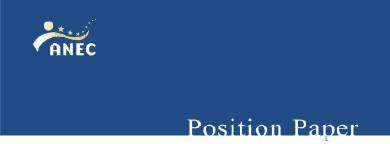
ANEC reccomendations on standardisation in Europe
A transparent procedure for the recruitment and evaluation of consultants of the European
standards bodies shall be established to ensure neutral and independent conformity checks
of standards.
At the European level, the European Commission should provide increased and stable funding
for consumer participation in European standardisation.
To ensure a better representation of consumers in international standardisation additional
financial support has to be provided.
I.B. Dispute Settlement Procedure
I.C. The Use of New Deliverables and Specifications in EU
Policies
II. Greater Involvement of Public Authorities in European Standardisation
II.B. Application of standards
II.C. Caution with respect to wider application of the New Approach
III. Efficiency
III.B. Transparency
III.C. TrainingIV. Financing
ANEC also calls for continued support initiatives to improve consumer representation in
standardisation in the Central and Eastern European countries, In particular, ANEC
suggests that the candidates for EU membership are requested to provide adequate funding
for consumer representation in standardisation and to ensure that national consensus
building arrangements are respected.
V. International Standardisation
V.B. Safeguarding Objectives of European Public Policy
Annex I
Examples of Inadequate European Standards
Annex II
Definitions
ANEC
International Organisation
grouping 30 industrialised countries:
Australia
Hungary
Poland
Austria
Iceland
Portugal
Belgium
Ireland
Slovak Republic
Canada
Ita ly
South Korea
Czech Republic
Japan
Spain
Denmark
Luxembourg
Sweden
Finland
Mexico
Switzerland
France
The Netherlands
Turkey
Germany
New Zealand
United Kingdom
Greece
Norway
United States
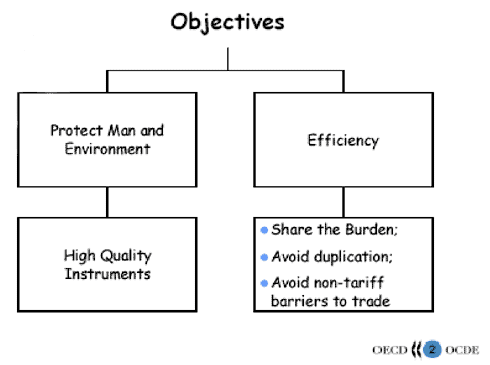
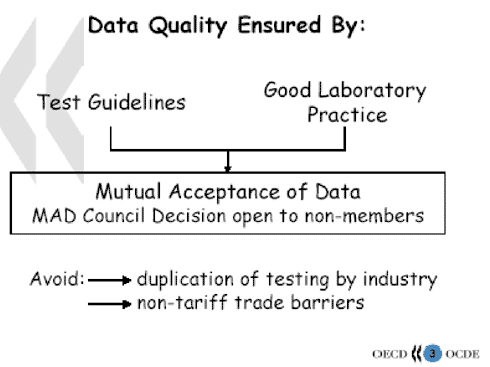
MAD and Non-Member Countries
![]()
Accept data from OECD countries (GLP, TG) ![]()
Assistance in developing compliance system ![]()
Participating in OECD work ![]()
OECD countries accept data from non-OECD countries (GLP, TG)
MAD: international standard open to all interested WTO
members
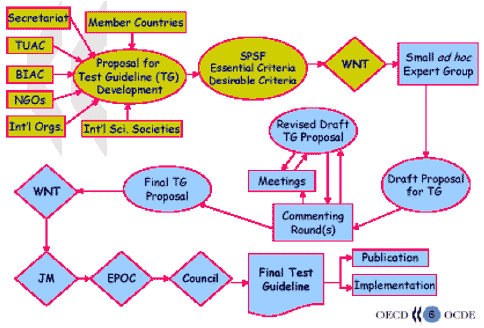
![]()
Submission of the Proposal ![]()
Completion of the Standard Project Submission Form (SPSF) ![]()
Priority Setting by National CO-ordinators ![]()
"Conducting the Work: Reaching Scientific Consenus" ![]()
Adoption of New Guideline
1. Submission of the Proposal by:
![]()
Member country ![]()
BIAC ![]()
TUAC ![]()
International Scientific Society ![]()
Secretariat
2. Completion of the Standard Project Submission Form (SPSF):
![]()
http://www.oecd.org /ehs/test ![]()
Essential Criteria ![]()
Desirable Criteria
![]()
Desirable Criteria to be met before considering a Proposal
![]()
Guideline intended for general/broad use ![]()
Scientifically valid, reliable, relevant ![]()
Addresses endpoints not yet covered ![]()
Existing national/regional protocols as a basis
![]()
Desirable Criteria to be met before considering a Proposal
![]()
Animal welfare concerns are addressed ![]()
Contributes to saving resources ![]()
For guidance documents:essential or helpful ![]()
For guidance documents:linked to a ![]()
Specific TG or for general guidance
3. Priority Setting by National Co-ordinators
![]()
By written procedure ![]()
High,Medium,Low ranking priorities ![]()
Proposal for the Annual Workplan ![]()
Endorsement by Joint Meeting
![]()
Physical-Chemical ![]()
Properties ![]()
Aquatic Ecotoxicity ![]()
TerrestrialEcotoxicity ![]()
Abiotic Degradation ![]()
Biodegradation
![]()
Bioaccumulation ![]()
Health Effects ![]()
Exposure ![]()
Data Analys ![]()
Animal Welfare
Total number of Experts in the data bade: 6,000
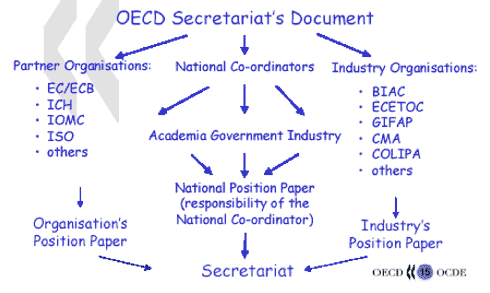
7. Adoption of New Guideline
![]()
Reaching scientific consenus ![]()
Approval by National co-ordinators ![]()
Endorsement by Joint Meeting ![]()
EPOC Approval for Submission to Council ![]()
Council Endorsement 2.3
What is the role of the New Approach in promoting environmental innovation? (Session III)
2.3.1
The proposed use of the New Approach in Integrated Product Policy
Sustainable Resources, consumption and waste
European Commission DG Environment
Otto. Linher@ece.eu.int
http://europa.eu.int/comm/environment/ipp
Sustainable Resources, consumption and waste
![]()
Strategic instrument to determine an optimal mix of policies to contribute
to the improvement of the environmental performance of products throughout their life
cycle
![]()
Prioritising, reinforcing and refocusing existing approaches
![]()
Complementing them by new elements where appropriate
Sustainable Resources, consumption and waste
![]()
Sustainable Development Strategy ![]()
Sixth Environment Action Programme ![]()
Thematic Strategies on Resources and Recycling
![]()
Chemical Policy ![]()
Waste Policy
Sustainable Resources, consumption and waste
![]()
Every actor should consider the life cycle environmental performance of
preducts as an element in taking his/her decisions on products ![]()
Prioritisation on:
![]()
Where are the biggest environmental impacts? ![]()
Where can we do most to reduce them?
![]()
Depth of analysis/use of LCA will depend on:
![]()
Importance of issue to be considered ![]()
Degree of clarity from the outset ![]()
Resources of concerned actor
Sustainable Resources, consumption and waste
![]()
Using the price mechanism
![]()
more fundamental change on the market are only likely if the consumer can
see the advantage in his/her pocket
![]()
Designing and marketing the products of the future
![]()
once a product is sold, there is rlatively little that can be done to change
its environmental performance
![]()
Creating consumer demand
![]()
all design improvements will be in vain if the consumer does not buy greener
products
Sustainable Resources, consumption and waste
![]()
Public action should concentrate on reducing environmental impacts where it
is most efficient
![]()
The most important decisions on the life cycle environmental performance of
products are taken at the design table and in purchse decisions.
![]()
All other phases may also play a role but are in general either rather minor
in importance or cannot be controlled easily
Sustainable Resources, consumption and waste
![]()
Command-and-control legislation:
![]()
Clear on results, including the way they have to be achieved
![]()
Can deal with high risk and high cost issues ![]()
Needs a lot of resources by public authorities (legislation,
administrations, enforcement) ![]()
Will we ever be able to regulate the bulk of issues needed to reinforce the
environmental designof products (Where shall we start and how long will it take us?)? ![]()
Should public authorities at all determine technical details of
environmental design of products?
![]()
Heavy procedure but needed whenever high risks and high costs are involved
Sustainable Resources, consumption and waste
![]()
Other supporting instruments
![]()
Encourage the availability of life cycle management instruments (LCA
databases, eco-design guidelines, environmental management tools, tools to enable
information flow)
![]()
Is the bottleneck availability of tools or the absence of drivers to apply
them?
![]()
Education and training
![]()
Large need for education training on eco-design (schools/universities) ![]()
However will education on environmental design be ever more than cherry on
the cake if businesses cannot make money with it?
![]()
Where can authorities achieve most with available resources?
Sustainable Resources, consumption and waste
![]()
The New Approach is put to the discussion as one of possible elements to
influence product design
![]()
However, the failure of the experience with the packaging Directive shows
the need to adopt innovative approaches to address the specificity of environmental issues
![]()
It is relatively easy to determine safety and fitness for use but very
difficult to specify the right balance between functionality of a product and it's
environmental characteristics
Sustainable Resources, consumption and waste
![]()
Eco-design guidelines and use of the enforement system to identify options
how to improve products
![]()
"New Deliverables"
![]()
Eco-labels as giving presumption of conformity
![]()
Key performance indicators
![]()
Combining various elements
Sustainable Resources, consumption and waste
![]()
If a large range of product-related environmentalt impacts is to be tackled,
there is no other way than putting responsibilityto designers and managers
![]()
Environmental management systems (EMAS, management standards such as ISO
14062 etc.) can play a key role!
![]()
Putting the responsibility to industry without accompanying the process will
not work
![]()
There need to be incentives and checks to make sure that the obligations for
environmetal management are taken seriously
Sustainable Resources, consumption and waste
![]()
The key to the making the New Approach work for the environment is not in
choosing one or the other option of instruments but setting up an intelligent mechanism
how various elements can be combined to create a clear and credible framework
![]()
Maybe such a framework should not be limited to the New Approach but be
rather a combination of various instruments based on setting clear political objectives
and delegating technical issues to businesses and technical bodies and keeping the option
of command and crontrol if necessary
Sustainable Resources, consumption and waste
![]()
For the moment, these are only preliminary ideas an no decisions have been
taken!!!
![]()
Setting essential requirements for environmental design of products in the
form of framework legislation (general or product-specific)
![]()
Producers could be obliged to use the state of art of environmental design
on their products ![]()
Obligation to use life cycle thinking/environmental management systems in
the design of their products (e.g. inspired by ISO 14062 or the packaging prevention
standards)
Sustainable Resources, consumption and waste
![]()
Producers could be obliged:
![]()
to use the state of art of environment design on their products ![]()
to use life style thinking/environmental management systems in the design of
their products (e.g. inspired by ISO 14062 or the packaging prevention standard) ![]()
to provide evidence that environmental aspects have been appropriately take
into account ![]()
to make key information on the environment balance of their products
available
Sustainable Resources, consumption and waste
![]()
Obligations to use the state of art on eco-design and life cycle thinking
could be general
![]()
However, the degree to which this would require written evidence, partial or
full Life Cycle Assessment will have to be differentiated according to (e.g.:)
![]()
size of the company ![]()
level of environmental impacts associated to product life style ![]()
volume of products sold ![]()
degree of clarity from the outset on the scientificevaluation
Sustainable Resources, consumption and waste
![]()
The essential requirements need to be completed by:
![]()
appropriate enforcement/market surveillance ![]()
the further definition of key requirements via various possible mechanisms
Sustainable Resources, consumption and waste
![]()
To check whether basic obligations (e.g. use of environmental management
system) have been fulfilled
![]()
To discuss with designers and managers whether and where further
improvements could be made
![]()
To collect and provide information to public authorities on possible areas
for improving product invironmental performance
Sustainable Resources, consumption and waste
![]()
Whereever substantial environmental improvements can be made that are not
carried by the market alone, more detailed requirements could be set via:
![]()
informal or formal discussion oor agreements with businesses and industry
associations ![]()
standardisation (i.e. the use of the New Approach technique) ![]()
working groups following the model of the IPPC Directive ![]()
product panels ![]()
introducing command and control elements on specific issues into the
framework directive ![]()
targets on the basis key performance indicators
Sustainable Resources, consumption and waste
![]()
Prioritisation should be made on importance of isssues and on the basis of
information by enforcement authorities, technical experts, NGOs etc.
![]()
There should be a "ladder of preferences" towards the more
informal instruments with the more stringent tols only used if necesary
![]()
The firther development of key requirements would need to take into account
the duration of design cycles to provide a clear and predictable framework for industry
Sustainable Resources, consumption and waste
![]()
The most obvious candidates are packaging and electrical and electronic
equipment as test cases
![]()
Possible later extension to further product design framework directive
Sustainable Resources, consumption and waste
![]()
"Environmental soundness" should become a feature of all European standards
![]()
To be addressed in a Comminication on Standardisation and the Environment ![]()
Strengthen participation of civil society actors ![]()
CEN environmental help desk ![]()
Possible mechanisms to strengthen the co-ordination between political and
technical bodies
Sustainable Resources, consumption and waste
![]()
IPPC could serve as an inspiration: definition of the state of art on
product eco-design similarly to BAT for installations
![]()
Eco-labelling: "pull-strategy" whereas "New Approach" is
"push-strategy": eco-label criteria could inspire instruments to define the
state of art of eco-design
![]()
EMAS:option to demonstrate conformity with the environmental management
obligation (if product-related aspects are considered)
Sustainable Resources, consumption and waste
![]()
Cementingthe existing state of art or driver for environmental innovation?
![]()
Level of ambition and clarity of essential requirements ![]()
Enforcement and control ![]()
"Feedback" from implementation will be crucial ![]()
Continuous further development of detailed requirements ![]()
"Create tension" to reward early movers in environmental design ![]()
Good co-ordination between technical and political levels of decision making
Sustainable Resources, consumption and waste
![]()
Discuss possible ideas within the Commission and agree on the main elements
to be described in the IPP White Paper (spring 2002) and invite stakeholders and the
European institutions to react
![]()
Discuss possible adaptations of the New Approach elements of the Packaging
Directive with Member States and determine a timetable
![]()
Active participation in the preparation of the planned Directive on
Electrical and Electronic Equipment (EEE) 2.3.2 Panel on
environmental innovation
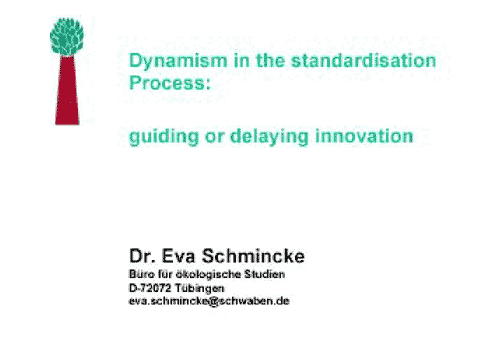
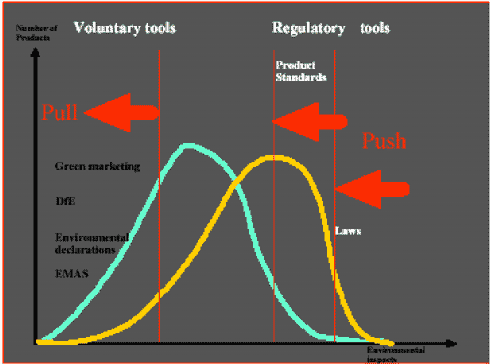
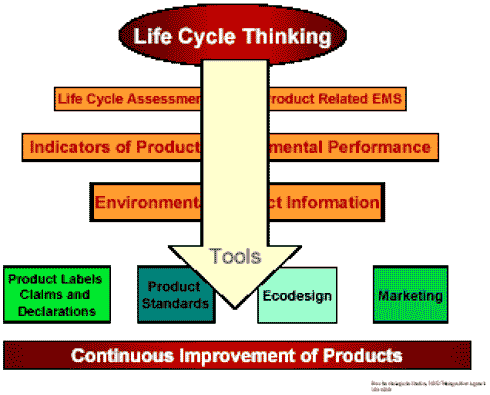
![]()
How can management standards encourage environmental environmental thinking
in product design?
![]()
Is a typical guidance document, encouraging environmental thinking in
product development and design ![]()
a generic document, not developed for certification ![]()
Has the potential for sector specific adaptation, e.g, EEE, focussing on:
![]()
Relevant phases of life cycle, e.g.use phase ![]()
Main impacts e.g. energy demand, hazardous substances ![]()
Relevant design strategies e.g.design for disassembly
![]()
Environmental management - Integrating environmental aspects into product design and
development ![]()
Scope:
![]()
Describes concepts and current practices.. ![]()
for alt these involved in design and development, ![]()
Stakeholders. ![]()
All types of goods and services, all sizes of enterprise ![]()
Final draft finished in October 2001 . voting spring 2002
![]()
Goals and potential benefits ![]()
Strategic considerations ![]()
Management considerations ![]()
Product considerations ![]()
Product design and development process
![]()
Description of broad consensus. industrialised and developing countries ![]()
Comprehensive concept Strategy, Organisation, Product ![]()
Definition of terms and setting concepts into context ![]()
Practical help boxes, e.g.for treating trade-offs ![]()
Road map through the development process and where to integrate
environmental aspects ![]()
Bibliography ark web sites
![]()
Goods and services, picks services examples ![]()
Continuous product development, Product redesign, System Innovation ![]()
Life Cycle Thinking f Multi-Criteria ![]()
Early Integration ![]()
Functionality/Economy/Environment Trade-Offs ![]()
Strategic product related environmental objectives
![]()
Is there a need to develop operational, product area specific methodologies
for LCA and how can this be done?
![]()
Basic for introducing environmental aspects into product standards and
product design. ![]()
Prerequisites already exist:
![]()
Standardised methodology for information input (LCA methodology) ![]()
Standardised procedures for processing and managing information (declaration
programs) ![]()
Existing standardised LCA methodology is becoming widely accepted,
![]()
Competition between softwares ![]()
Standardised data formates ![]()
In curricula at universities and schools ![]()
Further development needed:
![]()
Public, easily accessible data bases ![]()
• Experience with screening applications ![]()
• Revision of practice for critical review for communicating LCA
information
![]()
What elements would need to be in place to enable the New Approach to be
used effectively to encourage innovation?
![]()
Minimum requirements ![]()
Criteria ![]()
Verification ![]()
Stakeholder consultation 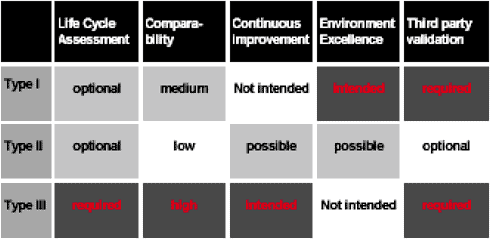
![]()
Stakeholder participation
![]()
At early stages to enable stakeholders owning the process and building up
responsibility for it
![]()
Transparency of procedures
![]()
To allow for sufficient public control
![]()
Effective revision procedures
![]()
To provide guidance e.g. on BAT without being prescriptive ![]()
To check guidance in terms of real environmental improvement 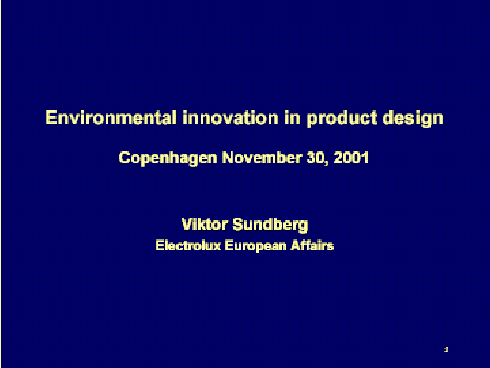
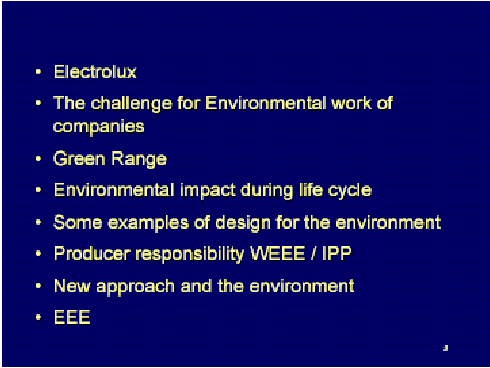
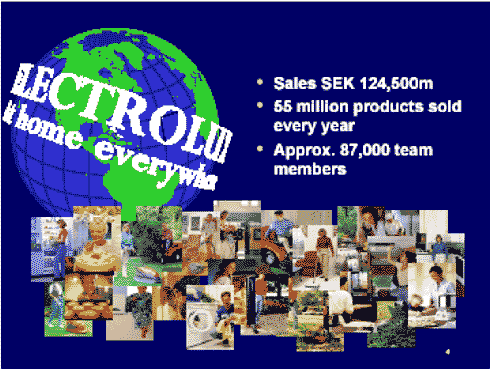
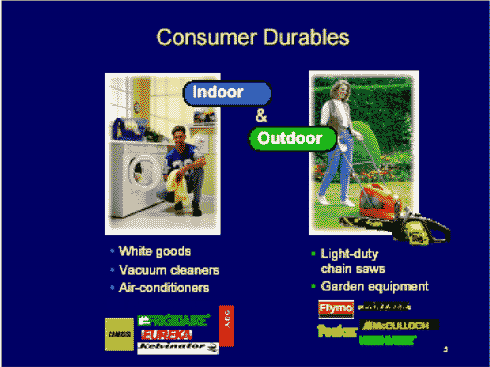
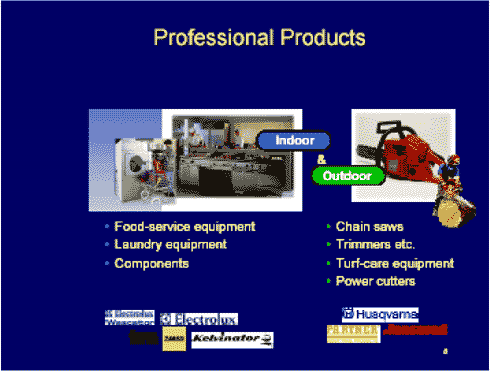
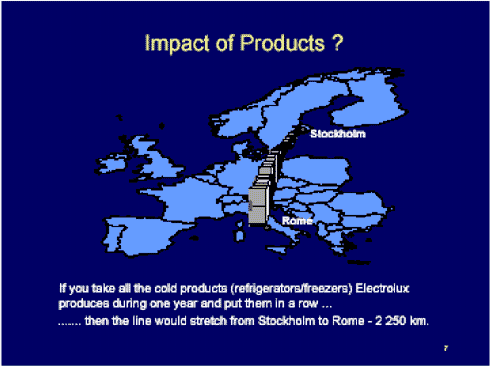
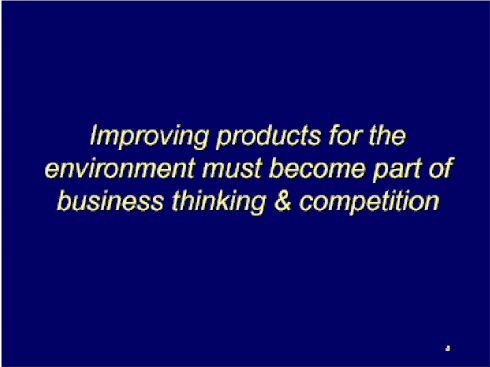
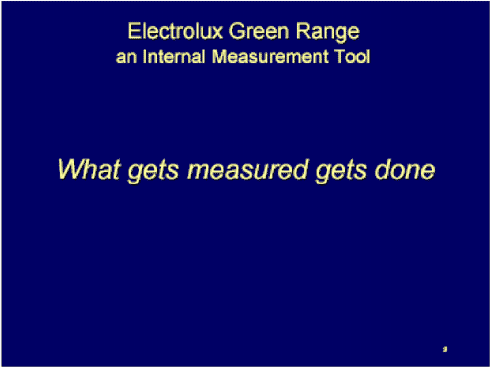
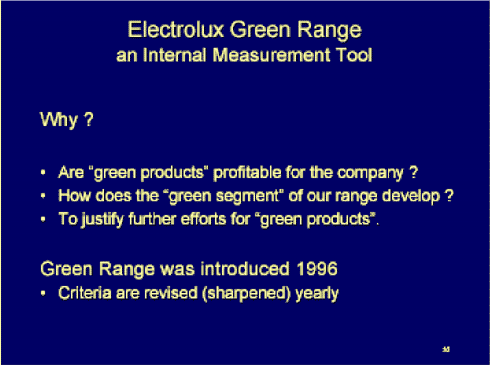

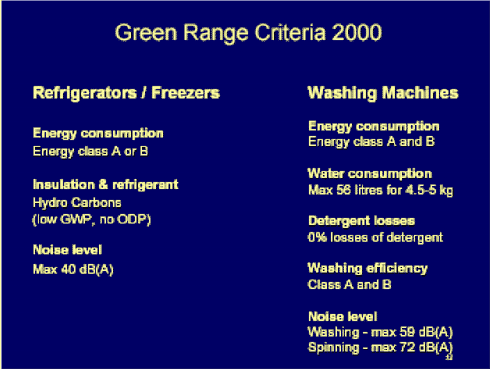

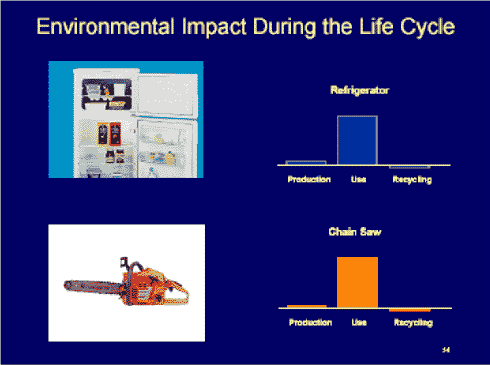
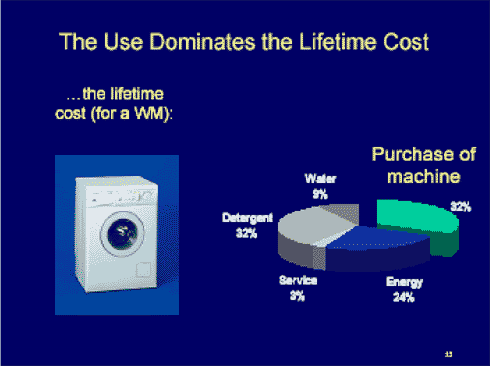
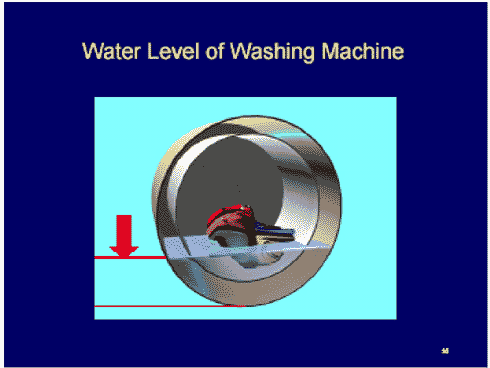
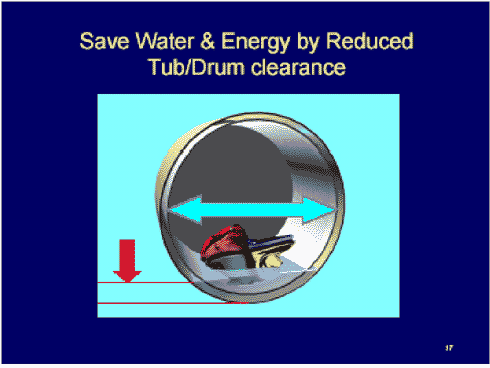
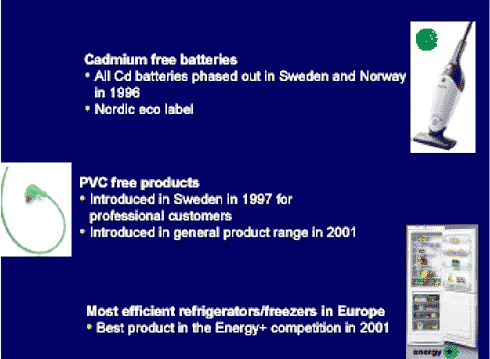
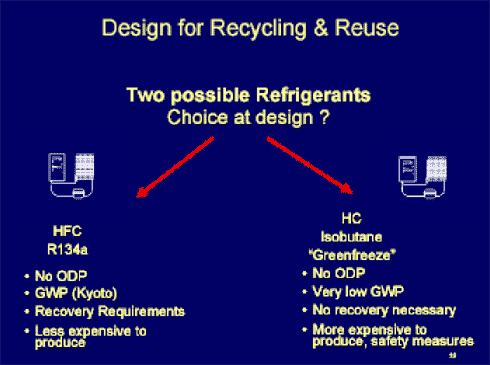
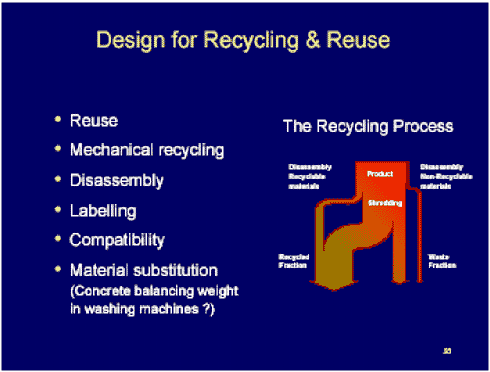
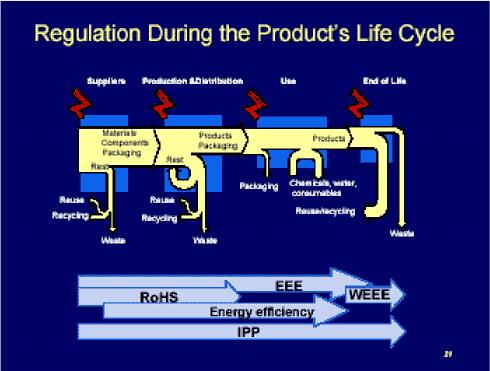
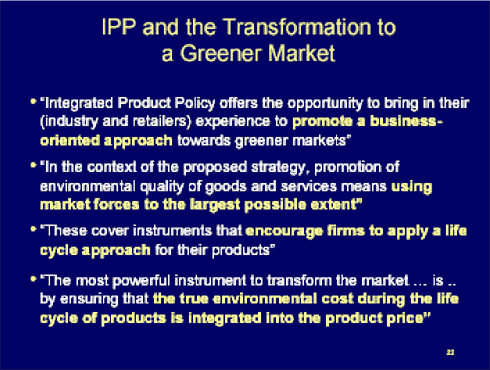

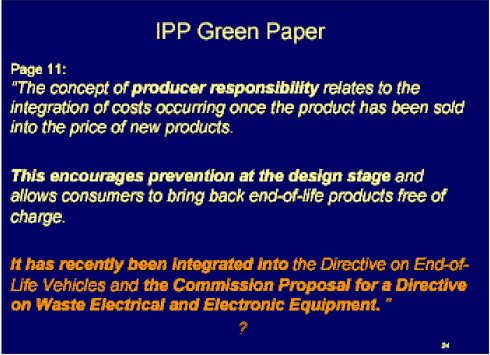
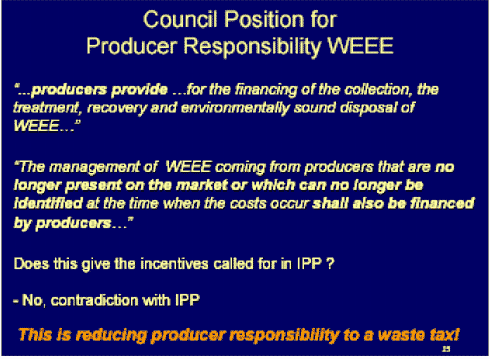
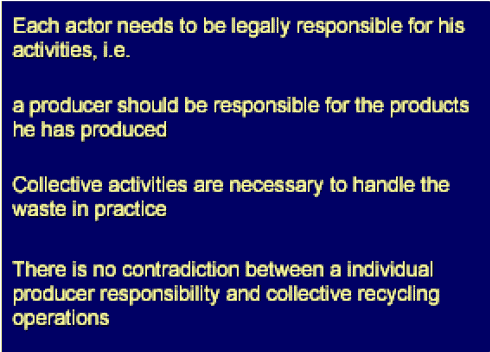
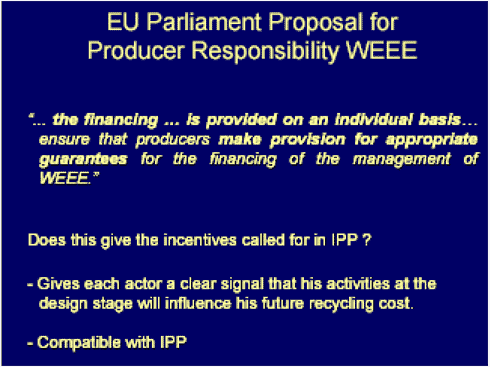
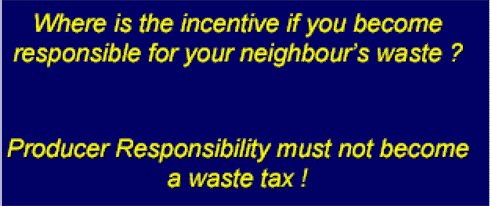
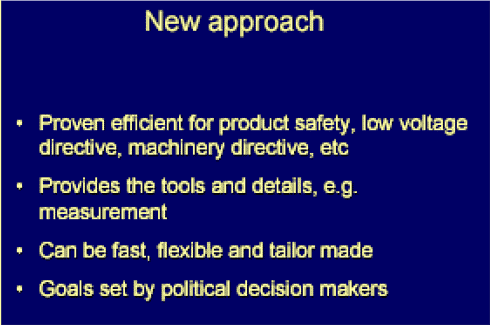
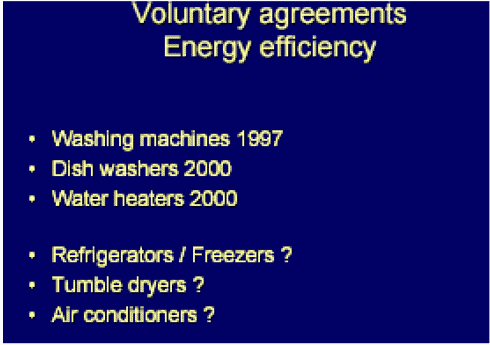
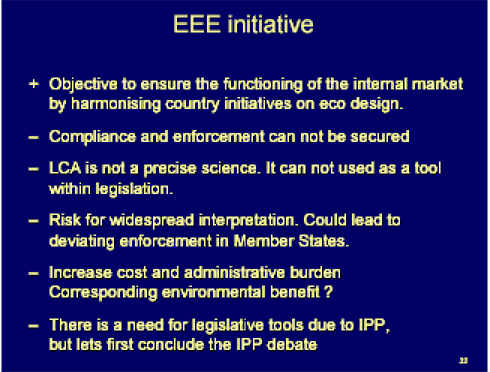
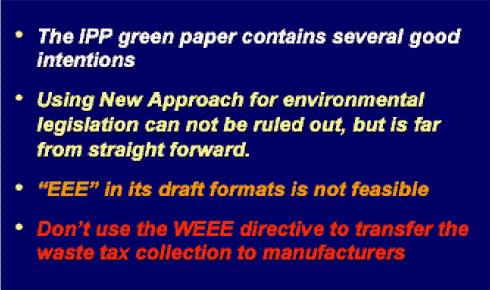
By Dr. Karola Taschner
Scientific Advisor
![]()
Minimum performance levels to be achieved ![]()
Orientations for the dimension of improvement needed (e.g. energy efficiency
targets) ![]()
Priorities for improvement (e.g. hazardous substances beyond the ROHS
directive, energy efficiency, water use) on the basis of the 6th .
Environmental Action Programme and a screening of the most relevant environmental aspects
of different groups of electronics ![]()
Key issues to be addressed (e.g. an abligatory switch off function – in
addition to stand-by for IT equipment)
![]()
Benchmarking according to best practice and state of the art, e.g.
requirements for using a certain level of recycled material, levels of energy efficiency,
restrictions on emissions ![]()
Establishing grades (or classes) of performance ![]()
Making a choice on which standards are needed
![]()
As the burden of proof for compliance with minimisation objectives is
imposed upon producers ![]()
Transparent decision-making (e.g. by documenting assessment of different
options and justification requirement, why not the best performing option has been
chosen). ![]()
Obligation to carry out a lifecycle assessment of products ![]()
Product to carry out a lifestyle assessment (POEM) ![]()
Environmental product information be forwarded
![]()
How can management standards encourage environmental thinking in product
design? Not at all. One bad example (packaging standards) should be sufficient. Management
standards can be an add-on to document that benchmarking standards have been met. ![]()
Is there a need to develop operational, product area specific methodology(s)
for LCA, and how can this be done?
![]()
Would it stimulate innovation if there were benchmarks starting from minimum
requirements that could be used for a system of verifiable environmental product
declarations? If so, how could these benchmarks be developed?
![]()
What "push strategies" should these be at EU or national level?
![]()
What elements would need to be in place to enable the New Approach to be
used effectively to encourage environmental innovation, e.g. mandatory minimum
requirements: criteria based on LCA methodologies, methods of verification, stakeholder
consultation.
1)
For example: CEN standards in the field or packaging and
environmental including prevention re-use. recycling and energy recovery of packaging
and packaging waste.
2)
Whilst product liability legislation might be very cost
intensive for the manulacturer in case of injuries or fatalities and thus seems to be an
incentive to take safety issues into account comparable incentives do not exist in the
environmental sector.